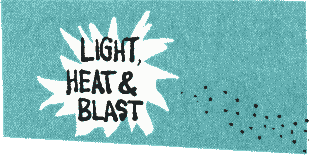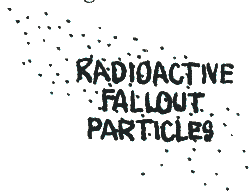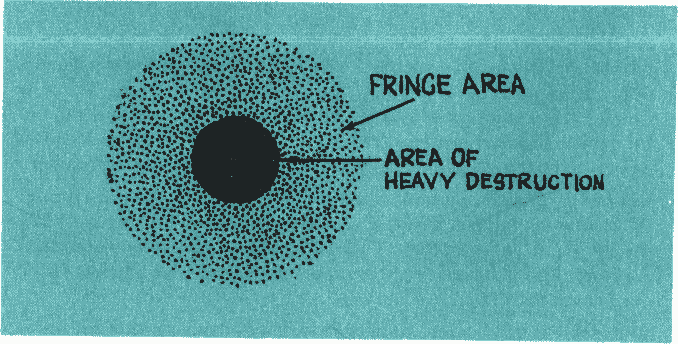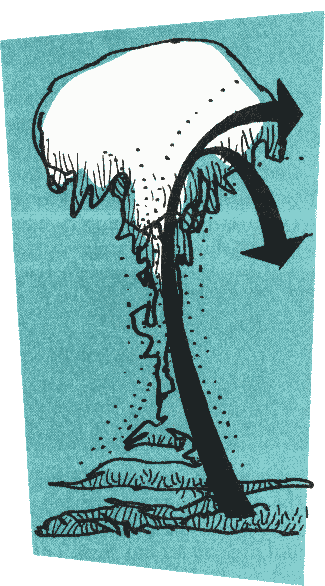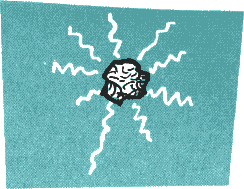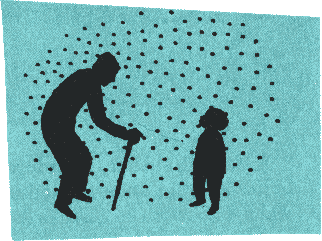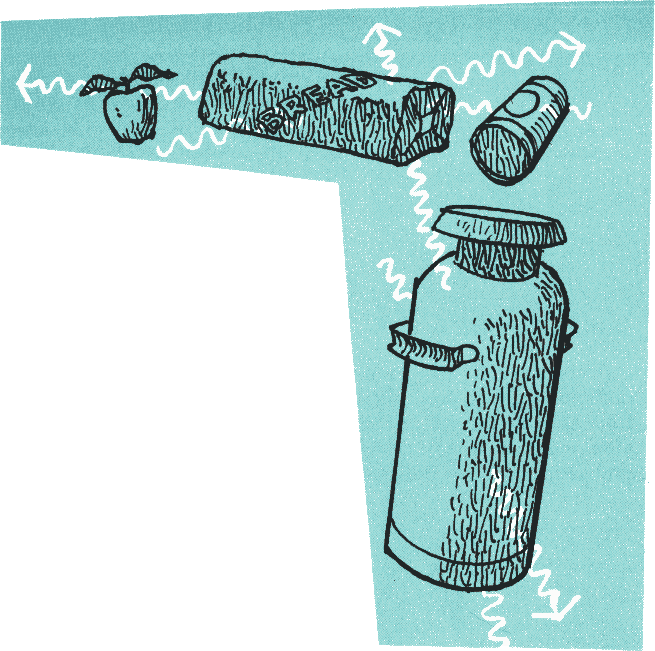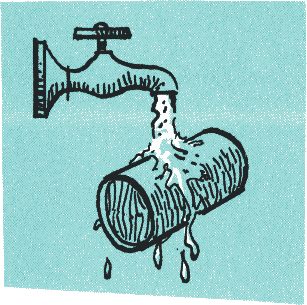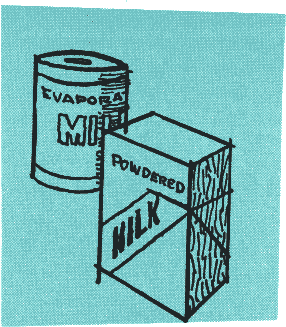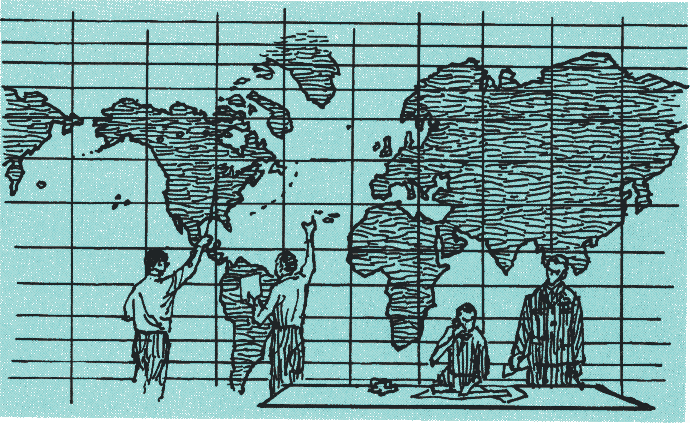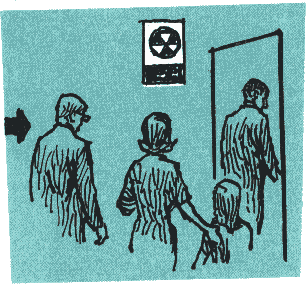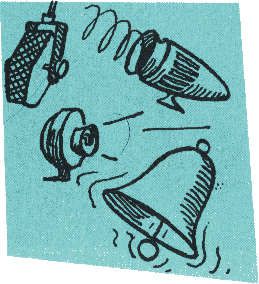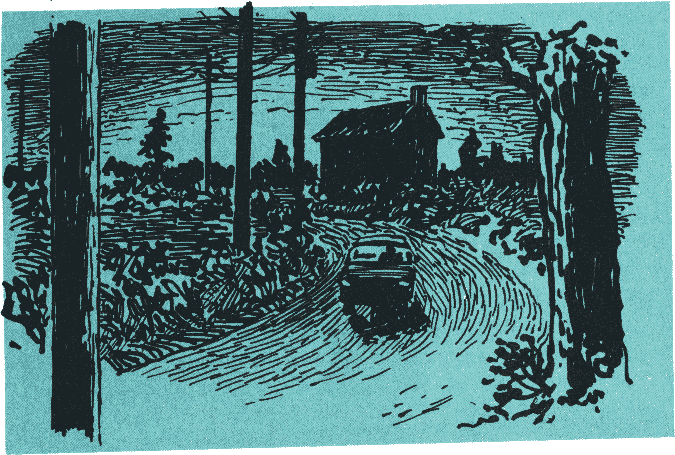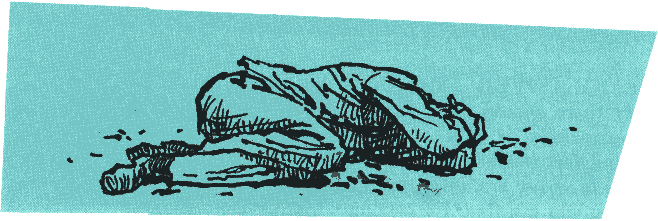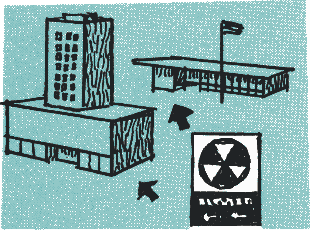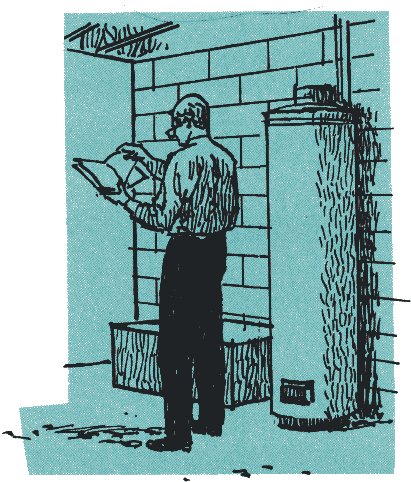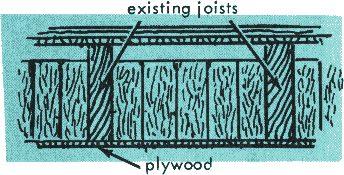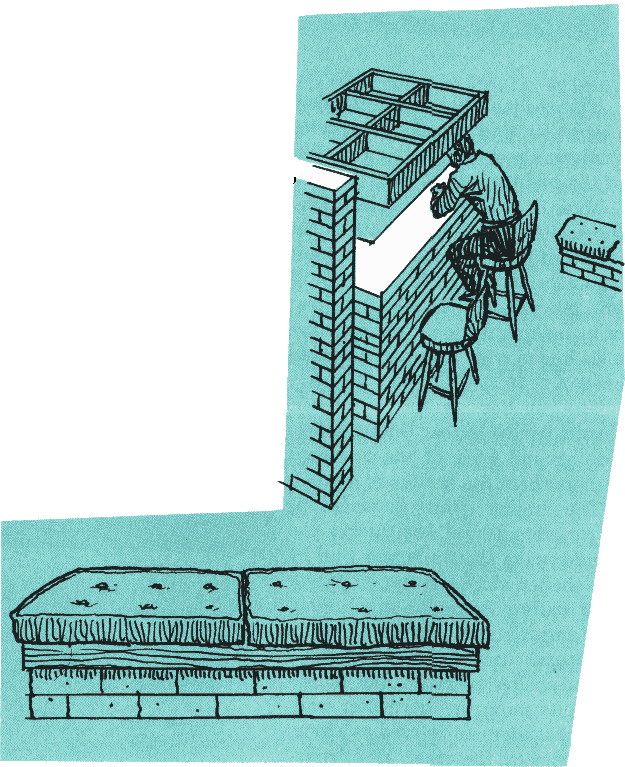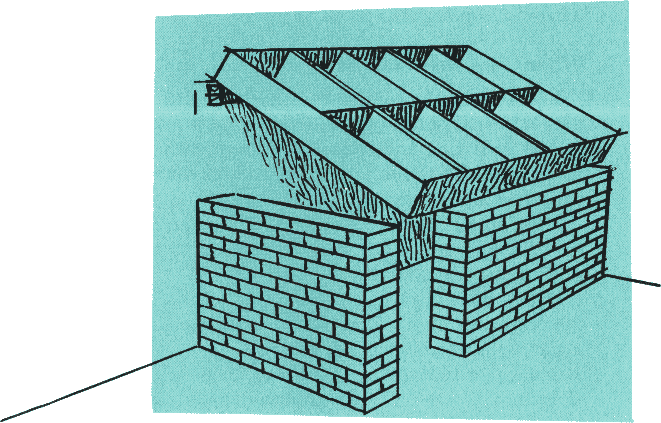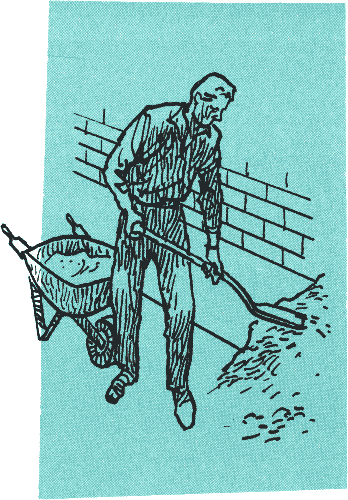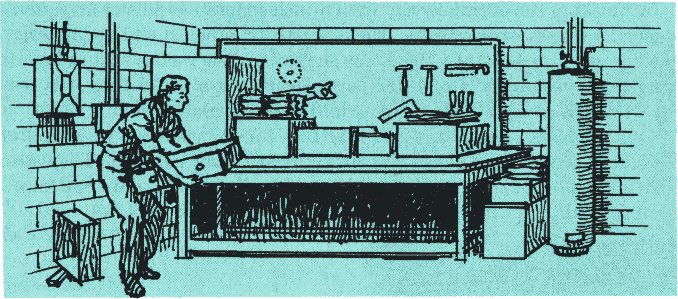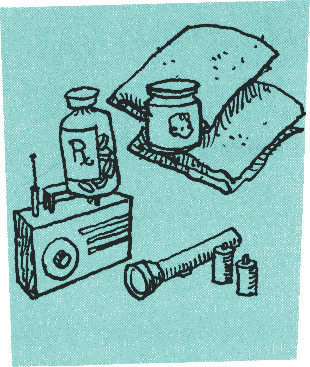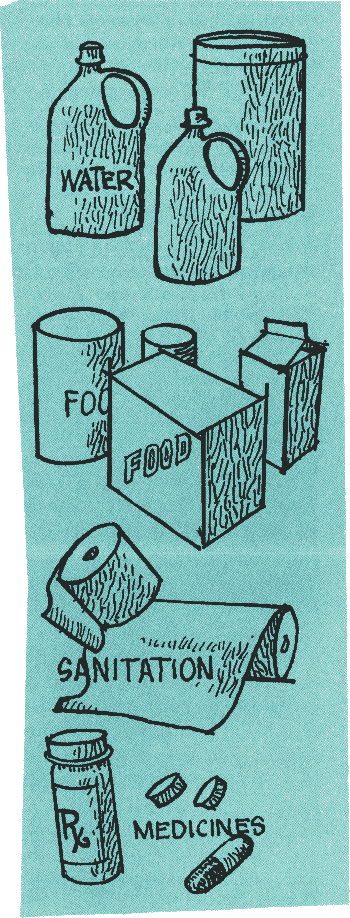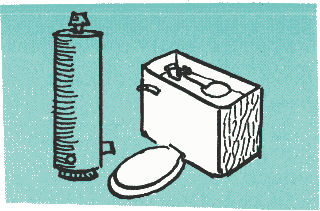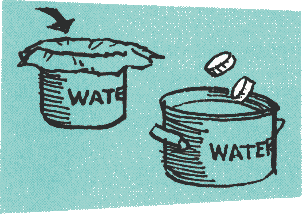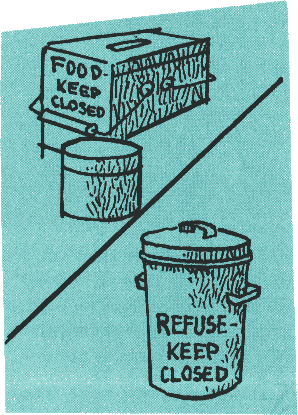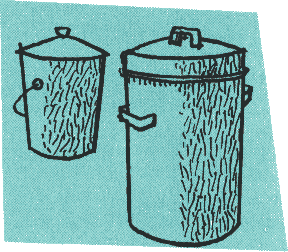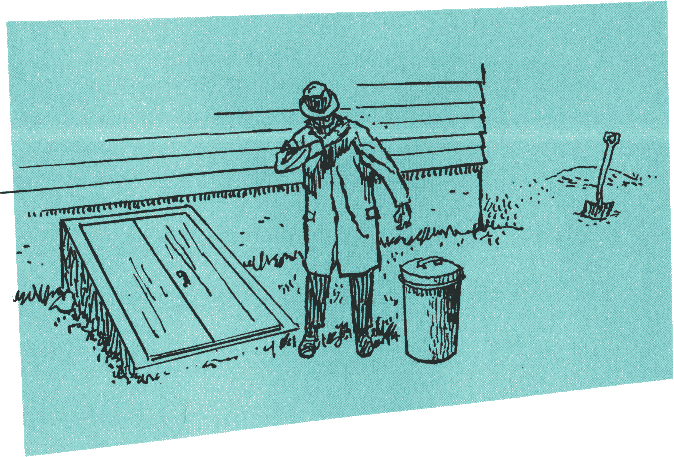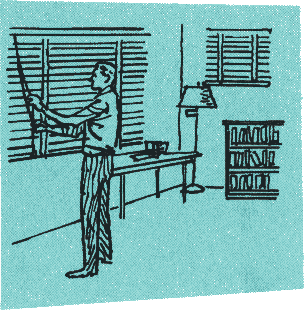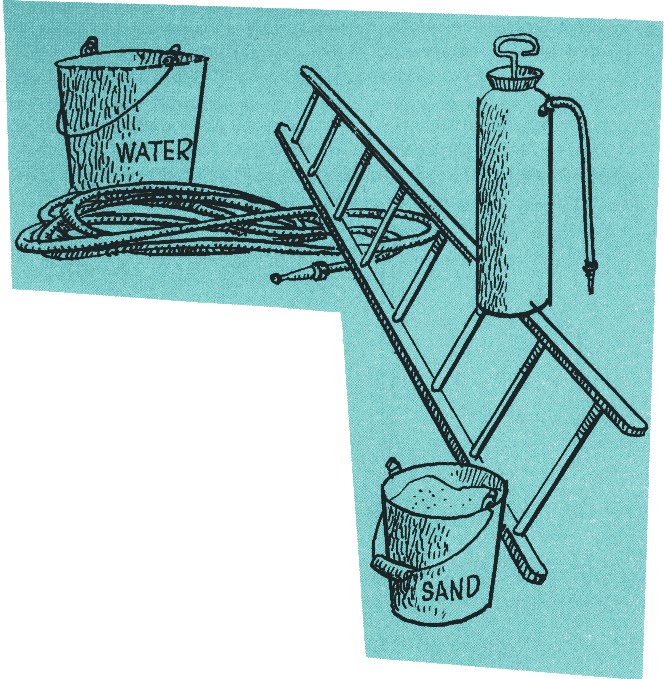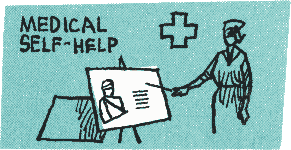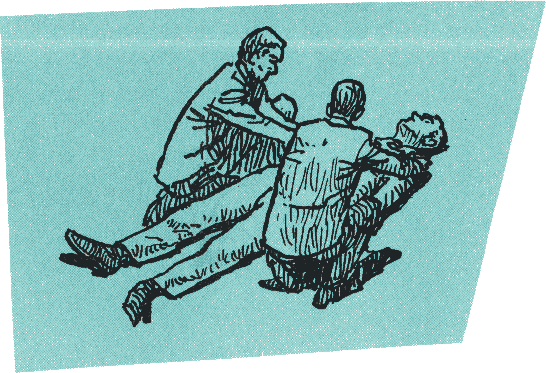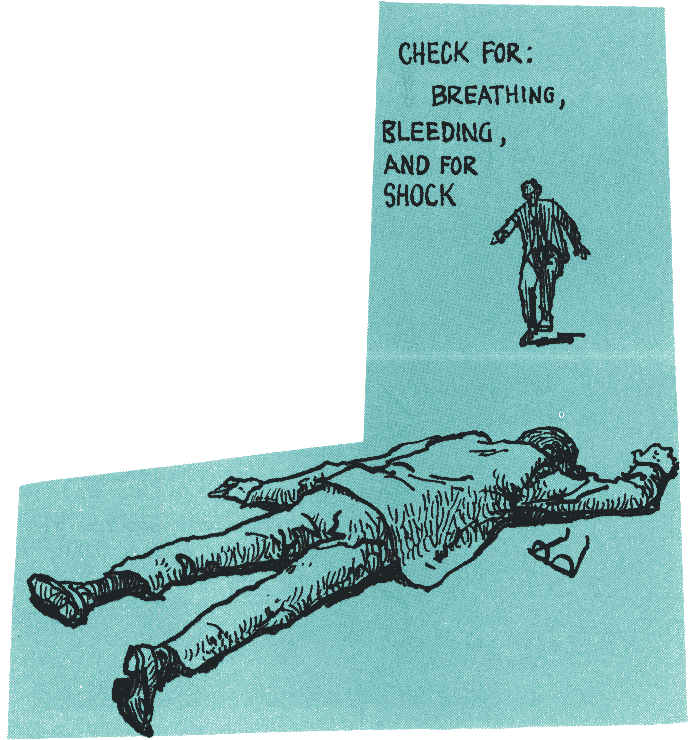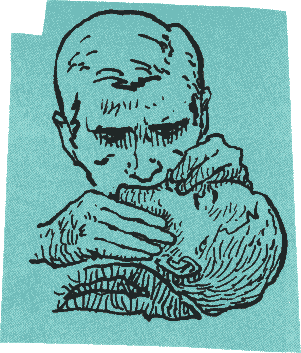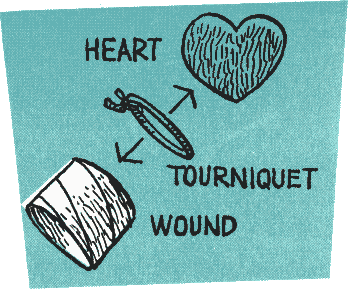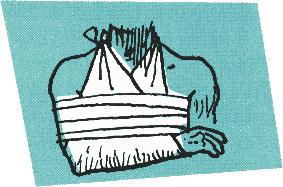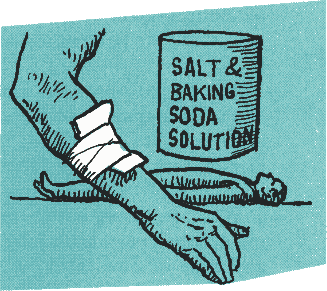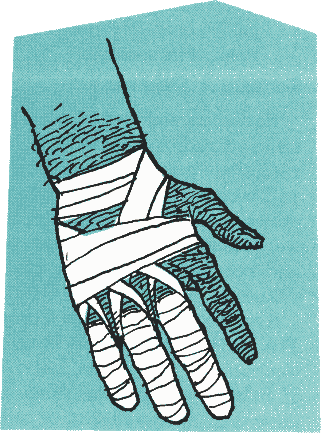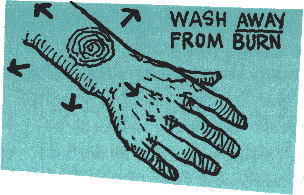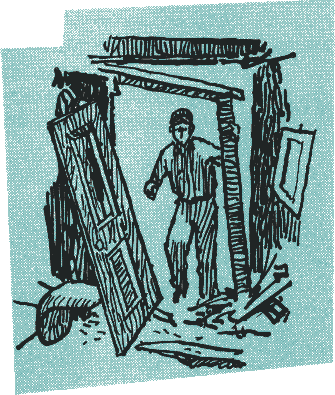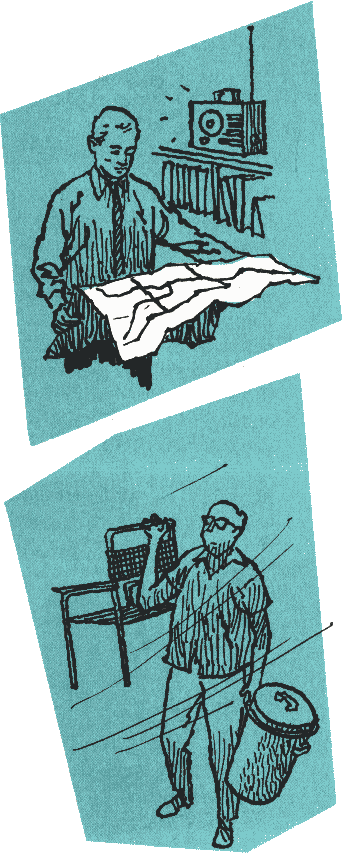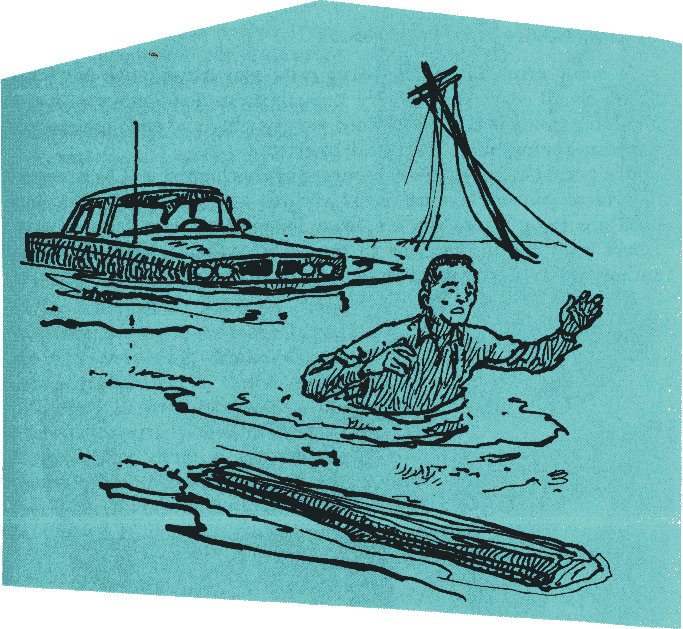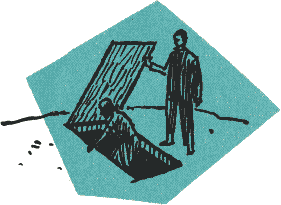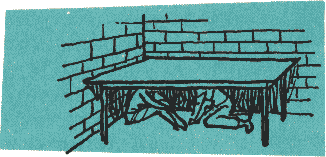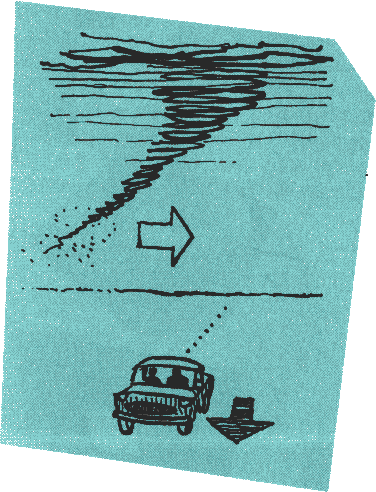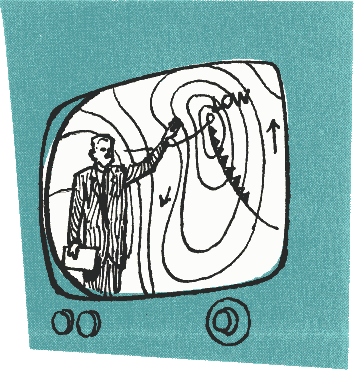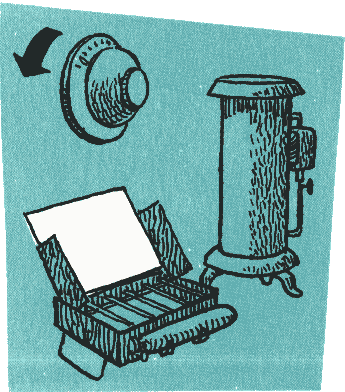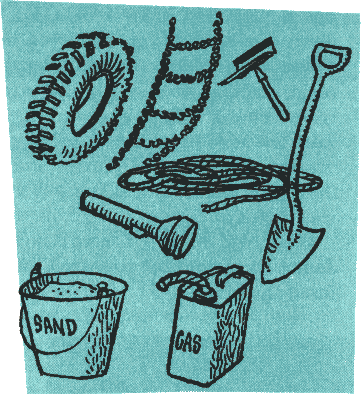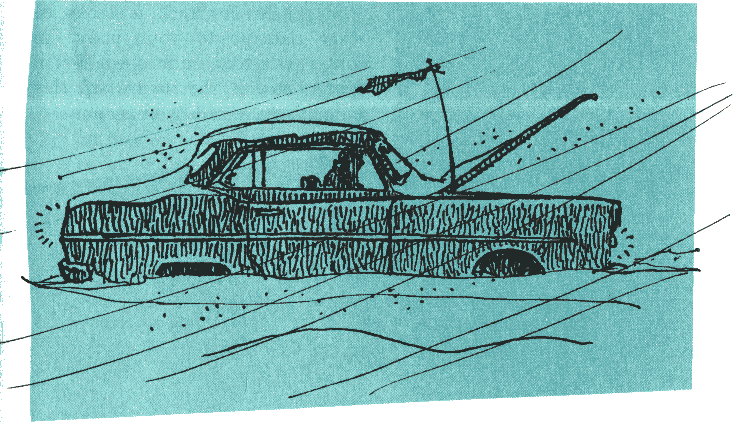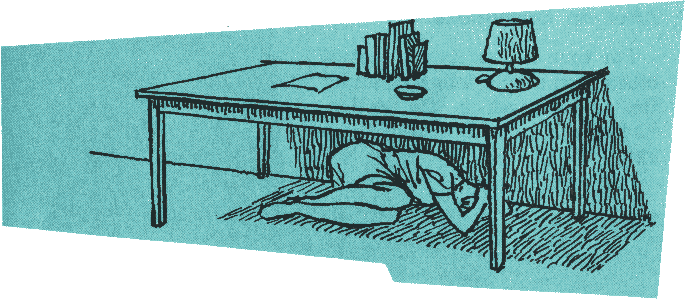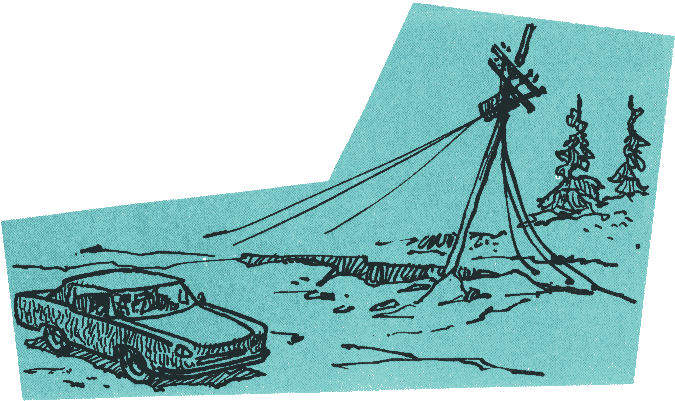H-14 March 1968
in time of
EMERGENCY
a citizen's handbook on
... NUCLEAR ATTACK
... NATURAL DISASTERS
DEPARTMENT OF DEFENSE OFFICE OF CIVIL DEFENSE
This handbook is the property of:
Name_____________________________________________
Address__________________________________________
Location of designated fallout shelter, or shelter nearest to:
Home_____________________________________________
School___________________________________________
Workplace________________________________________
Emergency telephone numbers:[1]
Ambulance________________________________________
Civil Defense____________________________________
Doctors__________________________________________
__________________________________________
Fire_____________________________________________
Health Department________________________________
Hospitals________________________________________
________________________________________
Police___________________________________________
Red Cross________________________________________
Utility Companies________________________________
________________________________
Weather Bureau___________________________________
Other____________________________________________
IN TIME OF EMERGENCY
a citizen's handbook on
--NUCLEAR ATTACK
--NATURAL DISASTERS
The Office of Civil Defense gratefully acknowledges the assistance provided by representatives of the following agencies and organizations in the preparation of material for this handbook:
U.S. Atomic Energy Commission
U.S. Department of Agriculture
U.S. Department of Commerce; Environmental Science Services
Administration; Weather Bureau
U.S. Department of Health, Education, and Welfare; Public
Health Service
Office of Emergency Planning, Executive Office of the President
American Medical Association; Committee on Disaster Medical
Care
American National Red Cross
National Geographic Society
National Association of State Civil Defense Directors
United States Civil Defense Council
The Office of Civil Defense, however, is solely responsible for the validity and accuracy of the information in the handbook.
Table of Contents
Introduction
PART I: NUCLEAR ATTACK
Chapter 1--Checklist of Emergency Actions
Chapter 2---Understand the Hazards of Nuclear Attack
Chapter 3--Know About Warning
Chapter 4--Fallout Shelters, Public and Private
Chapter 5--Improvising Fallout Protection
Chapter 6--Supplies for Fallout Shelters
Chapter 7--Water, Food, and Sanitation in a Shelter
Chapter 8--Fire Hazards
Chapter 9--Emergency Care of the Sick and Injured
PART II: MAJOR NATURAL DISASTERS
Chapter 1--General Guidance
Chapter 2--Floods and Hurricanes
Chapter 3--Tornadoes
Chapter 4--Winter Storms
Chapter 5--Earthquakes
Index
INTRODUCTION
A major emergency affecting a large number of people may occur anytime and anywhere.
It may be a peacetime disaster such as a flood, tornado, fire, hurricane, blizzard or earthquake. It could be an enemy nuclear attack on the United States.
In any type of general disaster, lives can be saved if people are prepared for the emergency, and know what actions to take when it occurs.
With the aid of Federal and State governments, cities and counties in all parts of the country are developing their local civil defense systems--the fallout shelters, supporting equipment and emergency plans needed to reduce the loss of life from an enemy attack.
While these local government systems have been set up mainly as safeguards against nuclear attack, they have saved lives and relieved suffering in many major peacetime disasters. People have been warned of impending storms and similar dangers, told how to protect themselves, sheltered from the elements, fed and clothed, treated for injury and illness, and given help in resuming their normal lives. Experience has shown that as cities, counties and towns develop their systems to preserve life under nuclear attack conditions, they also become better prepared to deal effectively with peacetime disasters.
In cooperation with the U.S. Office of Civil Defense and the States, many local governments are improving their civil defense systems by preparing community shelter plans. These plans include instructions to local citizens on what to do in the event of nuclear attack.
This handbook, "In Time of Emergency," contains basic general information on both nuclear attack and major natural disasters. This general guidance supplements the specific instructions issued by local governments. Since special conditions may exist in some communities, the local instructions may be slightly different from this general guidance. In those cases, the local instructions should be followed.
[pg 2]Part I (pages 3-68) is concerned with nuclear attack and basic actions to take.
Part II (pages 69-86) discusses preparations and emergency actions that will help individuals cope with major natural disasters--floods, hurricanes, tornadoes, winter storms, and earthquakes.
In addition to following the advice given in this handbook and the instructions of their local governments, people can prepare themselves better to meet any major disaster by taking training courses to develop their "emergency skills." Especially recommended are these courses:
"PERSONAL AND FAMILY SURVIVAL" (12-hour course)--A basic orientation course in civil defense, which also tells people how to improve their protection against the effects of a nuclear attack.
"MEDICAL SELF-HELP" (16-hour course)--How to care for the sick and injured if a doctor or nurse is not available.
"FIRST AID" (courses of various lengths)--How to help the sick and injured until professional medical assistance is obtained.
"CARE OF THE SICK AND INJURED" (12-hour course)--How to care for patients after they have received professional medical treatment.
Information on these free courses, which are given in most communities, is available from local Civil Defense Offices, County Agricultural Extension Agents, local public health departments, or American Red Cross chapters. Special advice for rural families on emergency actions related to crops and livestock is available from the U.S. Department of Agriculture.
PART ONE
NUCLEAR ATTACK
PART ONE
NUCLEAR ATTACK
A nuclear attack against the United States would take a high toll of lives. But our losses would be much less if people were prepared to meet the emergency, knew what actions to take, and took them.
A nationwide civil defense system now exists in the United States, and is being enlarged and improved constantly. The heart of this system is fallout shelter to protect people from the radioactive fallout that would result from a nuclear attack. The system also includes warning and communications networks, preparations to measure fallout radiation, control centers to direct lifesaving and recovery operations, emergency broadcasting stations, local governments organized for emergency operations, large numbers of citizens trained in emergency skills, and U.S. military forces available to help civil authorities and the public in a time of emergency.
If an enemy should threaten to attack the United States, you would not be alone. The entire Nation would be mobilizing to repulse the attack, destroy the enemy, and hold down our own loss of life. Much assistance would be available to you--from local, State and Federal governments, from the U.S. armed forces units in your area, and from your neighbors and fellow-Americans. If an attack should come, many lives would be saved through effective emergency preparations and actions.
You can give yourself and your family a much better chance of surviving and recovering from a nuclear attack if you will take time now to:
Understand the dangers you would face in an attack.
Make your own preparations for an attack.
Learn what actions you should take at the time of attack.
Chapter 1
CHECKLIST OF EMERGENCY ACTIONS
× KNOW YOUR LOCAL EMERGENCY ACTION PLAN
× Find out from your local government your local plan for emergency action.
× Determine the specific actions you and members of your family are expected to take.
× UNDERSTAND NUCLEAR ATTACK HAZARDS (See Chapter 2, page 9)
On the widespread threat of fallout, remember:
× The most dangerous period is the first 24 hours after fallout arrives. But you might have to use fallout shelter for up to two weeks.
× Highly dangerous amounts of fallout are visible. They look
like particles of sand or salt.× There is little danger that adults could inhale or swallow
enough fallout particles to hurt them. Small children, however, could be injured by drinking contaminated water or milk.× A person exposed to fallout radiation does not become radioactive. Radiation sickness is not contagious; one person cannot "catch it" from another person.
× KNOW THE ATTACK WARNING SIGNAL (See Chapter 3, page 17)
× On outdoor warning devices, the Attack Warning Signal is a 3- to 5-minute wavering sound, or a series of short blasts on whistles or horns.
× This signal means: An enemy attack against the United
States has been detected. Take protective action. (This signal has no other meaning, and will be used for no other purpose.)× On warning, don't use the phone. Get information from radio.
× KNOW THE LOCATION OF FALLOUT SHELTER (See Chapter 4, page 23)
× Public shelters are marked like this.
× Good shelters can be prepared in homes with basements.
× IF NO SHELTER IS AVAILABLE, IMPROVISE PROTECTION (See Chapter 5, page 33)
Remember:
× A basement corner below ground level, or a storm cellar, is
the best place to improvise fallout protection.× For the best possible protection, use heavy and dense materials
for shielding.
× PREPARE EMERGENCY SUPPLIES (See Chapter 6, page 39)
Especially important are:
× Water and other liquids.
× Food requiring no cooking.
× Special medicines.
× CONSERVE EMERGENCY SUPPLIES; MAINTAIN SANITATION (See Chapter 7, page 45)
× REDUCE FIRE HAZARDS (See Chapter 8, page 51)
× KNOW THE BASICS OF EMERGENCY MEDICAL CARE (See Chapter 9, page 55)
If no doctor is available, especially important are actions to:
× Restore breathing.
× Stop serious bleeding.
× Treat for shock.
× Treat broken bones and burns.
× FOLLOW OFFICIAL INSTRUCTIONS
Chapter 2
UNDERSTAND THE HAZARDS OF NUCLEAR ATTACK
SUMMARY
1. The main hazards of a nuclear attack are blast, heat, fire, and fallout radiation.
2. You may be able to protect yourself against blast and heat by getting inside a shelter or taking cover, before the nuclear explosions occur. You may be able to avoid fire injuries by putting out small fires or escaping from large fires that might occur in your area.
3. You can protect yourself against fallout radiation by getting inside a fallout shelter--if possible, before fallout particles begin drifting down--and by staying there until you are told to come out by authorities who have the equipment to measure radiation levels.
4. After a nuclear attack, food and water would be available to most people, and it would be usable. If any fallout particles have collected, they could be removed before the food is eaten or the water is drunk. People suffering from extreme hunger or thirst should not be denied food or water, even if the available supplies are not known to be free of fallout particles or other radioactive substances.
5. Infants and small children should be fed canned or powdered milk (if available) for awhile after the attack, unless the regular milk supply is uncontaminated. They should not be given water that may contain radioactive substances, if other water known to be pure is available.
6. A person cannot "catch" radiation sickness from another person.
UNDERSTAND THE HAZARDS OF NUCLEAR ATTACK
When a nuclear bomb or missile explodes, the main effects produced are intense light (flash), heat, blast, and radiation. How strong these effects are depends on the size and type of the weapon; how far away the explosion is; the weather conditions (sunny or rainy, windy or still); the terrain (whether the ground is flat or hilly); and the height of the explosion (high in the air, or near the ground).
All nuclear explosions cause light, heat and blast, which occur immediately. In addition, explosions that are on or close to the ground would create large quantities of dangerous radioactive fallout particles, most of which would fall to earth during the first 24 hours. Explosions high in the air would create smaller radioactive particles, which would not have any real effect on humans until many months or years later, if at all.[2]
What Would Happen in an Enemy Attack
If the U.S. should be attacked, the people who happened to be close to a nuclear, explosion--in the area of heavy destruction--probably would be killed or seriously injured by the blast, or by the heat of the nuclear fireball.
[pg 11]People a few miles away--in the "fringe area" of the explosion--would be endangered by the blast and heat, and by fires that the explosion might start. However, it is likely that most of the people in the fringe area would survive these hazards.
People who were outside the fringe area would not be affected by the blast, heat or fire. Department of Defense studies show that in any nuclear attack an enemy might launch against us, tens of millions of Americans would be outside the fringe areas. To them--and to people in the fringe areas who survived the blast, heat and fire--radioactive fallout would be the main danger. Protective measures against this danger can be taken.
What Is Fallout?
When a nuclear weapon explodes near the ground, great quantities of pulverized earth and other debris are sucked up into the nuclear cloud. There the radioactive gases produced by the explosion condense on and into this debris, producing radioactive fallout particles. Within a short time, these particles fall back to earth--the larger ones first, the smaller ones later. On the way down, and after they reach the ground, the radioactive particles give off invisible gamma rays--like X-rays--too much of which can kill or injure people. These particles give off most of their radiation quickly; therefore the first few hours or days after an attack would be the most dangerous period.
In dangerously affected areas the particles themselves would look like grains of salt or sand; but the rays they would give off could not be seen, tasted, smelled or felt. Special instruments would be required to detect the rays and measure their intensity.
Fallout Would Be Widespread
The distribution of fallout particles after a nuclear attack would depend on wind currents, weather conditions and other factors. There is no way of predicting in advance what areas of the country would be affected by fallout, or how soon the particles would fall back to earth at a particular location.
Some communities might get a heavy accumulation of fallout, while others--even in the same general area--might get little or none. No area in the U.S. could be sure of not getting fallout, and it is probable that some fallout particles would be deposited on most of the country.
Areas close to a nuclear explosion might receive fallout within 15-30 minutes. It might take 5-10 hours or more for the particles to drift down on a community 100 or 200 miles away.
Generally, the first 24 hours after fallout began to settle would be the most dangerous period to a community's residents. The heavier particles falling during that time would still be highly radioactive and give off strong rays. The lighter particles falling later would have lost much of their radiation high in the atmosphere.
[pg 13]Fallout Causes Radiation Sickness
The invisible gamma rays given off by fallout particles can cause radiation sickness--that is, illness caused by physical and chemical changes in the cells of the body. If a person receives a large dose of radiation, he will die. But if he receives only a small or medium dose, his body will repair itself and he will get well. The same dose received over a short period of time is more damaging than if it is received over a longer period. Usually, the effects of a given dose of radiation are more severe in very young and very old persons, and those not in good health.
No special clothing can protect people against gamma radiation, and no special drugs or chemicals can prevent large doses of radiation from causing damage to the cells of the body. However, antibiotics and other medicines are helpful in treating infections that sometimes follow excessive exposure to radiation (which weakens the body's ability to fight infections).
Almost all of the radiation that people would absorb from fallout particles would come from particles outside their own bodies. Only simple precautions would be necessary to avoid swallowing the particles, and because of their size (like grains of sand) it would be practically impossible to inhale them.
People exposed to fallout radiation do not become radioactive and thereby dangerous to other people. Radiation sickness is not contagious or infectious, and one person cannot "catch it" from another person.
Protection Is Possible
People can protect themselves against fallout radiation, and have a good chance of surviving it, by staying inside a fallout shelter. In most cases, the fallout radiation level outside the shelter would decrease rapidly enough to permit people to leave the shelter within a few days.
Even in communities that received heavy accumulations of fallout particles, people soon might be able to leave shelter for a few minutes or a few hours at a time in order to perform emergency tasks. In most places, it is unlikely that full-time shelter occupancy would be required for more than a week or two.
[pg 14]Many Kinds of Fallout Shelters
The farther away you are from the fallout particles outside, the less radiation you will receive. Also, the building materials (concrete, brick, lumber, etc.) that are between you and the fallout particles serve to absorb many of the gamma rays and keep them from reaching you.
A fallout shelter, therefore, does not need to be a special type of building or an underground bunker. It can be any space, provided the walls and roof are thick or heavy enough to absorb many of the rays given off by the fallout particles outside, and thus keep dangerous amounts of radiation from reaching the people inside the structure.
A shelter can be the basement or inner corridor of any large building; the basement of a private home; a subway or tunnel; or even a backyard trench with some kind of shielding material (heavy lumber, earth, bricks, etc.) serving as a roof.
In addition to protecting people from fallout radiation, most fallout shelters also would provide some limited protection against the blast and heat effects of nuclear explosions that were not close by.
Chapter 4 (pages 23-32) discusses the various types of fallout shelters that people can use to protect themselves in case of nuclear attack.
Food and Water Would Be Available and Usable
From many studies, the Federal Government has determined that enough food and water would be available after an attack to sustain our surviving citizens. However, temporary food shortages might occur in some areas, until food was shipped there from other areas.
Most of the Nation's remaining food supplies would be usable after an attack. Since radiation passing through food does not contaminate it, the only danger would be the actual swallowing of fallout particles that happened to be on the food itself (or on the can or package containing the food), and these could be wiped or washed off. Reaping, threshing, canning and other processing would prevent any dangerous quantities of fallout particles from getting into processed foods. If necessary to further protect the population, special precautions would be taken by food processors.
Water systems might be affected somewhat by radioactive fallout, but the risk would be small, especially if a few simple precautions were taken. Water stored in covered containers and water in covered wells would not be contaminated after an attack, because the fallout particles could not get into the water. Even if the containers were not covered (such as buckets or bathtubs filled with emergency supplies of water), as long as they were indoors it is highly unlikely that fallout particles would get into them.
Practically all of the particles that dropped into open reservoirs, lakes, and streams (or into open containers or wells) would settle to the bottom. Any that didn't would be removed when the water was filtered before being pumped to consumers. A small amount of radioactive material might dissolve in the water, but at most this would be of concern for only a few weeks.
Milk contamination from fallout is not expected to be a serious problem after an attack. If cows graze on contaminated pasture and swallow fallout particles that contain some radioactive elements, their milk might be harmful to the thyroid glands of infants and small children. Therefore, if possible, they should be given canned or powdered milk for a few weeks if authorities say the regular milk supply is contaminated by radioactive elements.
In summary, the danger of people receiving harmful doses of fallout radiation through food, water or milk is very small. People suffering from extreme hunger or thirst should not be denied these necessities after an attack, even if the only available supplies might contain fallout particles or other radioactive substances.
Chapter 3
KNOW ABOUT WARNING
SUMMARY
Before an emergency
1. Learn what outdoor warning signals are used in your community, what they sound like, what they mean, and what actions you should take when you hear them.
2. Make sure you know the difference between the Attack Warning Signal and the Attention or Alert Signal (if both are used in your community).
During an emergency
1. When you hear the warning signals, or warning information is broadcast, take prompt action.
2. If the Attack Warning Signal sounds, go to a fallout shelter immediately (unless your local government has told you to do something else). After you are in shelter, listen to a radio for more information and instructions.
3. If there is no public or private shelter you can go to, try to improvise some fallout protection. As a last resort, take cover in the best available place.
4. If there should be a nuclear flash--especially if you feel the warmth from it--take cover instantly, and then move to a fallout shelter later.
KNOW ABOUT WARNING
An enemy attack on the United States probably would be preceded by a period of international tension or crisis. This crisis period would help alert all citizens to the possibility of attack.
If an attack actually occurs, it is almost certain that incoming enemy planes and missiles would be detected by our networks of warning stations in time for citizens to get into shelters or at least take cover. This warning time might be as little as 5-15 minutes in some locations, or as much as an hour or more in others.
How you received warning of an attack would depend on where you happened to be at that time. You might hear the warning given on radio or television, or even by word-of-mouth. Or your first notice of attack might come from the outdoor warning system in your own city, town or village.
Many U.S. cities and towns have outdoor warning systems, using sirens, whistles, horns or bells. Although they have been installed mainly to warn citizens of enemy attack, some local governments also use them in connection with natural disasters and other peacetime catastrophes.
Different cities and towns are using their outdoor warning systems in different ways. Most local governments, however, have decided to use a certain signal to warn people of an enemy attack, and a different signal to notify them of a peacetime disaster.
[pg 19]The Standard Warning Signals
The two "standard" signals that have been adopted in most communities are these:
THE ATTACK WARNING SIGNAL. This will be sounded only in case of enemy attack. The signal itself is a 3- to 5-minute wavering sound on the sirens, or a series of short blasts on whistles, horns or other devices, repeated as deemed necessary. The Attack Warning Signal means that an actual enemy attack against the United States has been detected, and that protective action should be taken immediately. This signal has no other meaning, and will be used for no other purpose.
THE ATTENTION OR ALERT SIGNAL. This is used by some local governments to get the attention of citizens in a time of threatened or impending natural disaster, or some other peacetime emergency. The signal itself is a 3-to 5-minute steady blast on sirens, whistles, horns or other devices. In most places, the Attention or Alert Signal means that the local government wants to broadcast important information on radio or television concerning a peacetime disaster. (See Chapter 1 of Major Natural Disasters section of this handbook.)
What To Do When Signals Sound
1. If you should hear the Attack Warning Signal--unless your local government has instructed you otherwise--go immediately to a public fallout shelter marked like this, or to your home fallout shelter. Turn on a radio, tune it to any local station that is broadcasting, and listen [pg 20]for official information. Follow whatever instructions are given.
If you are at home and there is no public or private shelter available, you may be able to improvise some last-minute protection for yourself and your family by following the suggestions in Chapter 5 (pages 33-38) of this handbook. As a last resort, take cover anywhere you can.
2. If you should hear the Attention or Alert Signal, turn on a radio or TV set, tune it to any local station, and follow the official instructions being broadcast.
Don't Use the Telephone
Whichever signal is sounding, don't use the telephone to obtain further information and advice about the emergency. Depend on the radio or television, since the government will be broadcasting all the information it has available. The telephone lines will be needed for official calls. Help keep them open.
Learn Your Community's Signals Now
As mentioned before not all communities in the U.S. have outdoor warning systems, and not all communities with warning systems have adopted the two "standard" warning signals.
You should therefore find out now from your local Civil Defense Office what signals are being used, in your community; what they sound like; what they mean; and what actions you should take when you hear them. Then memorize this information, or write it down on a card to carry with you at all times. Also, post it in your home. Check at least once each year to see if there are any changes.
[pg 21]If There Is a Nuclear Flash
It is possible--but extremely unlikely--that your first warning of an enemy attack might be the flash of a nuclear explosion in the sky some distance away. Or there might be a flash after warning had been given, possibly while you were on your way to shelter.
TAKE COVER INSTANTLY. If there should be a nuclear flash--especially if you are outdoors and feel warmth at the same time--take cover instantly in the best place you can find. By getting inside or under something within a few seconds, you might avoid being seriously burned by the heat or injured by the blast wave of the nuclear explosion. If the explosion were some distance away, you might have 5 to 15 seconds before being seriously injured by the heat, and perhaps 30 to 60 seconds before the blast wave arrived. Getting under cover within these time limits might save your life or avoid serious injury. Also, to avoid injuring your eyes, never look at the flash of an explosion or the nuclear fireball.
WHERE TO TAKE COVER. You could take cover in any kind of a building, a storm cellar or fruit cellar, a subway station or tunnel--or even in a ditch or culvert alongside the road, a highway underpass, a storm sewer, a cave or outcropping of rock, a pile of heavy materials, a trench or other excavation. Even getting under a parked automobile, bus or train, or a heavy piece of furniture, would protect you to some extent. If no cover is available, simply lie down on the ground and curl up. The important thing is to avoid being burned by the heat, thrown about by the blast, or struck by flying objects.
BEST POSITION AFTER TAKING COVER. After taking cover you should lie on your side in a curled-up position, and cover your head with your arms and hands. This would give you some additional protection.
MOVE TO A FALLOUT SHELTER LATER. If you protected yourself against the blast and heat waves by instantly taking cover, you could get protection from the radioactive fallout (which would arrive later) by moving to a fallout shelter.
Chapter 4
FALLOUT SHELTERS, PUBLIC AND PRIVATE
SUMMARY
Before an emergency
1. Learn the locations of the public fallout shelters that your local government wants you to go to in a time of attack. If no instructions of this kind have been issued, learn the locations of the public shelters nearest to you when you are at home, work, or school. Make sure each member of the family knows these locations.
2. If there is no public fallout shelter near your home, prepare a permanent or preplanned family shelter at home.
During an emergency
1. When you are warned of an enemy attack, go immediately to a public fallout shelter or to your own home shelter, unless your local government has given you other instructions.
2. Stay in shelter until you receive official notice that it is safe to come out.
FALLOUT SHELTERS, PUBLIC AND PRIVATE
After a nuclear attack, fallout particles would drift down on most areas of this country. To protect themselves from the radiation given off by these particles, people in affected areas would have to stay in fallout shelters for 2 or 3 days to as long as 2 weeks. Many people would go to public fallout shelters, while others--through choice or necessity--would take refuge in private or home fallout shelters.
Identifying Public Shelters
Most communities now have public fallout shelters that would protect many of their residents against fallout radiation. Where there are still not enough public shelters to accommodate all citizens, efforts are being made to provide more. In the meantime, local governments plan to make use of the best available shelter.
Most of the existing public shelters are located in larger buildings and are marked with this standard yellow-and-black fallout shelter sign. Other public shelters are in smaller buildings, subways, tunnels, mines and other facilities. These also are marked with shelter signs, or would be marked in a time of emergency.
Learn the Locations of Public Shelters
An attack might come at any hour of the day or night. Therefore you should find out now the locations of those public fallout shelters designated by your local government for your use. If no designations have yet been made, learn the locations of public shelters that are nearest to you when you are at home, work, school, or any other place where you spend considerable time.
This advice applies to all members of the family. Your children especially should be given clear instructions now on where to find a fallout shelter at all times of the day, and told what other actions they should take in case an attack should occur.
A Home Shelter May Save Your Life
Public fallout shelters usually offer some advantages over home shelters. However, in many places--especially suburban and rural areas--there are few public shelters. If there is none near you, a home fallout shelter may save your life.
The basements of some homes are usable as family fallout shelters as they now stand, without any alterations or changes--especially if [pg 25]the house has two or more stories, and its basement is below ground level.
However, most home basements would need some improvements in order to shield their occupants adequately from the radiation given off by fallout particles. Usually, householders can make these improvements themselves, with moderate effort and at low cost. Millions of homes have been surveyed for the U.S. Office of Civil Defense by the U.S. Census Bureau, and these householders have received information on how much fallout protection their basements would provide, and how to improve this protection.
Shielding Material Is Required
In setting up any home fallout shelter, the basic aim is to place enough "shielding material" between the people in the shelter and the fallout particles outside.
Shielding material is any substance that would absorb and deflect the invisible rays given off by fallout particles outside the house, and thus reduce the amount of radiation reaching the occupants of the shelter. The thicker or denser the shielding material is, the more it would protect the shelter occupants.
Some radiation protection is provided by the existing, standard walls and ceiling of a basement. But if they are not thick or dense enough, other shielding material will have to be added.
Concrete, bricks, earth and sand are some of the materials that are dense or heavy enough to provide fallout protection. For comparative purposes, 4 inches of concrete would provide the same shielding density as:
--5 to 6 inches of bricks.
--6 inches of sand or gravel . . . .\ May be packed into bags, cartons, boxes,
--7 inches or earth. . . . . . . . ./ or other containers for easier handling.
--8 inches of hollow concrete blocks (6 inches if filled with sand).
--10 inches of water.
--14 inches of books or magazines.
--18 inches of wood.
[pg 26]How To Prepare a Home Shelter
If there is no public fallout shelter near your home, or if you would prefer to use a family-type shelter in a time of attack, you should prepare a home fallout shelter. Here is how to do it:
A PERMANENT BASEMENT SHELTER. If your home basement--or one corner of it--is below ground level, your best and easiest action would be to prepare a permanent-type family shelter there. The required shielding material would cost perhaps $100-$200, and if you have basic carpentry or masonry skills you probably could do the work yourself in a short time.
Here are three methods of providing a permanent family shelter in the "best" corner of your home basement--that is, the corner which is most below ground level. If you decide to set up one of these shelters, first get the free plan for it by writing to Civil Defense, Army Publications Center, 2800 Eastern Blvd. (Middle River), Baltimore, Md. 21220. In ordering a plan, use the full name shown for it.
[pg 27]Ceiling Modification Plan A
If nearly all your basement is below ground level, you can use this plan to build a fallout shelter area in one corner of it, without changing the appearance of it or interfering with its normal peacetime use.
However, if 12 inches or more of the basement wall is above ground level, this plan should not be used unless you add the "optional walls" shown in the sketch.
Overhead protection is obtained by screwing plywood sheets securely to the joists, and then filling the spaces between the joists with bricks or concrete blocks. An extra beam and a screwjack column may be needed to support the extra weight.
Building this shelter requires some basic woodworking skills and about $150-$200 for materials. It can be set up while the house is being built, or afterward.
[pg 28]Alternate Ceiling Modification Plan B
This is similar to Plan A, except that new extra joists are fitted into part of the basement ceiling to support the added weight of the shielding (instead of using a beam and a screwjack column).
The new wooden joists are cut to length and notched at the ends, then installed between the existing joists.
After plywood panels are screwed securely to the joists, bricks or concrete blocks are then packed tightly into the spaces between the joists. The bricks or blocks, as well as the joists themselves, will reduce the amount of fallout radiation penetrating downward into the basement.
Approximately one-quarter of the total basement ceiling should be reinforced with extra joists and shielding material.
Important: This plan (like Plan A) should not be used if 12 inches or more of your basement wall is above ground level, unless you add the "optional walls" inside your basement that are shown in the Plan A sketch.
[pg 29]Permanent Concrete Block or Brick Shelter Plan C
This shelter will provide excellent protection, and can be constructed easily at a cost of $150 in most parts of the country.
Made of concrete blocks or bricks, the shelter should be located in the corner of your basement that is most below ground level. It can be built low, to serve as a "sitdown" shelter; or by making it higher you can have a shelter in which people can stand erect.
The shelter ceiling, however, should not be higher than the outside ground level of the basement corner where the shelter is located.
The higher your basement is above ground level, the thicker you should make the walls and roof of this shelter, since your regular basement walls will provide only limited shielding against outside radiation.
Natural ventilation is provided by the shelter entrance, and by the air vents shown in the shelter wall.
This shelter can be used as a storage room or for other useful purposes in non-emergency periods.
[pg 30]A PREPLANNED BASEMENT SHELTER. If your home has a basement but you do not wish to set up a permanent-type basement shelter, the next best thing would be to arrange to assemble a "preplanned" home shelter. This simply means gathering together, in advance, the shielding material you would need to make your basement (or one part of it) resistant to fallout radiation. This material could be stored in or around your home, ready for use whenever you decided to set up your basement shelter.
Here are two kinds of preplanned basement shelters. If you want to set up one of these, be sure to get the free plan for it first by writing to Civil Defense, Army Publications Center, 2800 Eastern Blvd. (Middle River), Baltimore, Md. 21220. Mention the full name of the plan you want.
Preplanned Snack Bar Shelter Plan D
This is a snack bar built of bricks or concrete blocks, set in mortar, in the "best" corner of your basement (the corner that is most below ground level). It can be converted quickly into a fallout shelter by lowering a strong, hinged "false ceiling" so that it rests on the snack bar.
When the false ceiling is lowered into place in a time of emergency, the hollow sections of it can be filled with bricks or concrete blocks. These can be stored conveniently nearby, or can be used as room dividers or recreation room furniture (see bench in sketch).
[pg 31]Preplanned Tilt-Up Storage Unit Plan E
A tilt-up storage unit in the best corner of your basement is another method of setting up a "preplanned" family fallout shelter.
The top of the storage unit should be hinged to the wall. In peacetime, the unit can be used as a bookcase, pantry, or storage facility.
In a time of emergency, the storage unit can be tilted so that the bottom of it rests on a wall of bricks or concrete blocks that you have stored nearby.
Other bricks or blocks should then be placed in the storage unit's compartments, to provide an overhead shield against fallout radiation.
The fallout protection offered by your home basement also can be increased by adding shielding material to the outside, exposed portion of your basement walls, and by covering your basement windows with shielding material.
You can cover the above-ground portion of the basement walls with earth, sand, bricks, concrete blocks, stones from your patio, or other material.
You also can use any of these substances to block basement windows and thus prevent outside fallout radiation from entering your basement in that manner.
A PERMANENT OUTSIDE SHELTER. If your home has no basement, or if you prefer to have a permanent-type home shelter in your yard, you can obtain instructions on how to construct several different kinds of outside fallout shelters by writing to the U.S. Office of Civil Defense, Department of Defense, Washington, D.C. 20310. There is no charge for these.
When To Leave Shelter
You should not come out of shelter until you are told by authorities that it is safe to do so. Special instruments are needed to detect fallout radiation and to measure its intensity. Unless you have these instruments, you will have to depend on your local government to tell you when to leave shelter.
This information probably would be given on the radio, which is one reason why you should keep on hand a battery-powered radio that works in your shelter area.
If you came out of shelter too soon, while the fallout particles outside were still highly radioactive, you might receive enough radiation to make you sick or even kill you.
Remember that fallout particles can be seen, but the rays they give off cannot be seen. If you see unusual quantities of gritty particles outside (on window ledges, sidewalks, cars, etc.) after an attack, you should assume that they are fallout particles, and therefore stay inside your shelter until you are told it is safe to come out.
Chapter 5
IMPROVISING FALLOUT PROTECTION
SUMMARY
Before an emergency
1. If there is no public fallout shelter near your home and you have decided not to prepare a permanent or preplanned shelter in your basement or yard, make sure that you have on hand now the materials and tools needed to improvise an emergency shelter at home. These would include shielding material (for an inside shelter), and lumber and a shovel (for an outside shelter).
During an emergency
1. If you have no better shelter to go to, improvise an emergency shelter at home.
2. Usually, the best place for an improvised shelter would be in your basement or storm cellar.
3. If you don't have a basement or storm cellar, you might be able to improvise a shelter in the crawl space under your house, outside in your yard, or (as a last resort) on the ground floor of your house. In some places, a boat would provide some fallout protection.
IMPROVISING FALLOUT PROTECTION
If an enemy attack should occur when you are at home, and you have made no advance shelter preparations, you still might be able to improvise a shelter either inside or outside your house. In a time of emergency, the radio broadcasts may tell you whether you have time to improvise a shelter or should take cover immediately.
An improvised shelter probably would not give you as much protection as a permanent or a preplanned family shelter, but any protection is better than none, and might save your life.
The best place to improvise a shelter would be the basement or storm cellar, if your home has one.
Shielding Material Needed
To improvise a shelter you would need shielding materials such as those mentioned on page 25--concrete blocks, bricks, sand, etc. Other things could also be used as shielding material, or to support shielding material, such as:
--House doors that have been taken off their hinges (especially heavy outside doors).
--Dressers and chests (fill the drawers with sand or earth after they are placed in position, so they won't be too heavy to carry and won't collapse while being carried).
--Trunks, boxes and cartons (fill them with sand or earth after they are placed in position).
--Tables and bookcases.
--Large appliances (such as washers and dryers).
--Books, magazines, and stacks of firewood or lumber.
--Flagstones from outside walks and patios.
[pg 35]Improvising a Basement Shelter
Here are two ways of improvising fallout protection in the basement of a home:
Set up a large, sturdy table or workbench in the corner of your basement that is most below ground level.
On the table, pile as much shielding material as it will hold without collapsing. Around the table, place as much shielding material as possible.
When family members are "inside the shelter"--that is, under the table--block the opening with other shielding material.
If you don't have a large table or workbench available--or if more shelter space is needed--place furniture or large appliances in the corner of the basement so they will serve as the "walls" of your shelter.
As a "ceiling" for it, use doors from the house that have been taken off their hinges. On top of the doors, pile as much shielding material as they will support. Stack other shielding material around the "walls" of your shelter.
When all persons are inside the shelter space, block the opening with shielding material.
[pg 36]Using a Storm Cellar for Fallout Protection
A below-ground storm cellar can be used as an improvised fallout shelter, but additional shielding material may be needed to provide adequate protection from fallout radiation.
If the existing roof of the storm cellar is made of wood or other light material, it should be covered with one foot of earth or an equivalent thickness of other shielding material (see page 25) for overhead shielding from fallout. More posts or braces may be needed to support the extra weight.
After the roof has been shielded, better protection can be provided by blocking the entrance way with 8-inch concrete blocks or an equivalent thickness of sandbags, bricks, earth or other shielding material, after all occupants are inside the shelter. A few inches should be left open at the top for air. After particles have stopped falling, the outside door may be left open to provide better ventilation.
If shielding material is not available for the entrance way, shelter occupants should stay as far away from it as possible. They also should raise the outside door of the storm cellar now and then to knock off any fallout particles that may have collected on it.
Using the Crawl Space Under Your House
Some homes without basements have "crawl space" between the first floor and the ground underneath the house. If you have this space under your house--and if the house is set on foundation walls, rather than on pillars--you can improvise fallout protection for your family there.
First, get access to the crawl space through the floor or through the outside foundation wall. (A trapdoor or other entry could be made now, before an emergency occurs.)
As the location for your shelter, select a crawl-space area that is under the center of the house, as far away from the outside foundation walls as possible.
[pg 37]Around the selected shelter area, place shielding material-- preferably bricks or blocks, or containers filled with sand or earth--from the ground level up to the first floor of the house, so that the shielding material forms the "walls" of your shelter area. On the floor above, place other shielding material to form a "roof" for the shelter area.
If time permits, dig out more earth and make the shelter area deeper, so you can stand erect or at least sit up in it.
Improvising an Outside Shelter
If your home has no basement, no storm cellar and no protected crawl space, here are two ways of improvising fallout protection in your yard:
Dig an L-shaped trench, about 4 feet deep and 3 feet wide. One side of the L, which will be the shelter area, should be long enough to accommodate all family members. The other side of the L can be shorter, since its purpose is to serve as an entrance-way and to reduce the amount of radiation getting into the shelter area.
Cover the entire trench with lumber (or with house doors that have been taken off their hinges), except for about 2 feet on the short side of the L, to provide access and ventilation.
On top of the lumber or doors, pile earth 1 to 2 feet high, or cover them with other shielding material.
If necessary, support or "shore up" the walls of the trench, as well as the lumber or doors, so they will not collapse.
Dig a shallow ditch, 6 inches deep and 6 inches wide, parallel to and 4 feet from the outside wall of your house.
Remove the heaviest doors from the house. Place the bottoms of the doors in the ditch (so they won't slip), and lean the doors against the wall of the house.
On the doors, pile 12 to 18 inches of earth or sand. Stack or pile other shielding material at the sides of the doors, and also on the other side of the house wall (to protect you against radiation coming from that direction).
If possible, make the shelter area deeper by digging out more earth inside it. Also dig some other shallow ditches, to allow rain water to drain away.
[pg 38]An Improvised Shelter on the Ground Floor
If your home has no basement or storm cellar (and no crawl space that is surrounded by foundation walls up to the first floor), you can get some limited fallout protection by improvising a fallout shelter on the first or ground floor of your house. However, this type of shelter probably would not give you nearly as much protection as the other types of improvised shelters described in this chapter.
Use an inner hall, inner room or large clothes closet on the ground floor, away from outside walls and windows.
With doors, furniture and appliances, plus stacks of other shielding material, you can create an enclosure large enough to live in for a short time. If possible, use boxes filled with sand or earth as shielding material, and fill drawers and trunks with sand or earth.
If there is not room for the shielding material in the limited space of a closet or small room, you can place the material on the other sides of the walls, or on the floor overhead.
Boats as Improvised Shelters
If no better fallout protection is available, a boat with an enclosed cabin could be used. However, in addition to emergency supplies such as food, drinking water and a battery-powered radio, you should have aboard the items you would need (a broom, bucket, or pump-and-hose) to sweep off or flush off any fallout particles that might collect on the boat.
The boat should be anchored or cruised slowly at least 200 feet offshore, where the water is at least 5 feet deep. This distance from shore would protect you from radioactive fallout particles that had fallen on the nearby land. A 5-foot depth would absorb the radiation from particles falling into the water and settling on the bottom.
If particles drift down on the boat, stay inside the cabin most of the time. Go outside now and then, and sweep or flush off any particles that have collected on the boat.
Chapter 6
SUPPLIES FOR FALLOUT SHELTERS
SUMMARY
Before an emergency
1. If you intend to go to a public fallout shelter in a time of attack, find out now whether it has emergency supplies in it.
--If it has emergency supplies, always keep on hand at home (or in your car) those few additional supplies you would need to take with you.
--If it does not have emergency supplies, always keep on hand at home all the supplies you would need to take with you.
2. If you intend to use a family fallout shelter at home, always keep on hand, in and around your home, all the supplies and equipment you would need for a shelter stay of two weeks.
During an emergency
1. If you are going to a public fallout shelter, take with you the supplies you will need.
2. If you are going to your home fallout shelter, gather up the supplies and equipment you want to take to the shelter area with you.
SUPPLIES FOR FALLOUT SHELTERS
People gathered in public and private fallout shelters to escape fallout radiation after a nuclear attack would have to stay there--at least part of the time--for a week or two.
During this time they would need certain supplies and equipment in order to stay alive and well, and to cope with emergency situations that might occur in their shelters.
This chapter tells you what supplies and equipment to take with you if you go to a public fallout shelter, and what items you should keep on hand if you plan to use a family fallout shelter at home.
What To Take to a Public Fallout Shelter
To augment the supply of food and liquids usually found in large buildings, most public fallout shelters are stocked--and others are being stocked--with emergency supplies. These include water containers, emergency food rations, sanitation items, basic medical supplies, and instruments to measure the radiation given off by fallout particles.
If the public shelter you will use in a time of attack contains these or other emergency supplies, you should plan to take with you only these additional items:
--Special medicines or foods required by members of your family, such as insulin, heart tablets, dietetic food or baby food.
--A blanket for each family member.
--A battery-powered radio, a flashlight, and extra batteries.
If the public shelter you are going to does not contain emergency supplies, you should take with you all the above items, plus as much potable liquids (water, fruit and vegetable juices, etc.) and ready-to-eat food as you can carry to the shelter.
[pg 41]Stocks for a Home Shelter
If you intend to use a home fallout shelter, you should gather together now all the things you and your family would need for 2 weeks, even though you probably wouldn't have to remain inside shelter for that entire period.
All these items need not be stocked in your home shelter area. They can be stored elsewhere in or around your house, as long as you could find them easily and move them to your shelter area quickly in a time of emergency.
The Absolute Necessities. There are a few things you must have. They are water, food, sanitation supplies, and any special medicines or foods needed by family members such as insulin, heart tablets, dietetic food and baby food.
The Complete List. In addition to the absolute necessities, there are other important items. Some of them may be needed to save lives. At the least, they will be helpful to you. Here is a list of all major items--both essential and desirable.
WATER. This is even more important than food. Enough water should be available to give each person at least one quart per day for 14 days. Store it in plastic containers, or in bottles or cans. All should have tight stoppers. Part of your water supply might be "trapped" water in the pipes of your home plumbing system, and part of it might be in the form of bottled or canned beverages, fruit or vegetable juices, or milk. A water-purifying agent (either water-purifying tablets, or 2 percent tincture of iodine, or a liquid chlorine household bleach) should also be stored, in case you need to purify any cloudy or "suspicious" water that may contain bacteria.
FOOD. Enough food should be kept on hand to feed all shelter occupants for 14 days, including special foods needed by infants, elderly persons, and those on limited diets. Most people in shelter can get along on about half as much food as usual. If possible store canned or sealed-package foods, preferably those not requiring refrigeration or cooking. These should be replaced periodically. Here is a table showing the suggested replacement periods, in months, for some of the types of food suitable to store for emergency use.[3]
| Milk: | Months |
| Evaporated | 6 |
| Nonfat dry or whole dry milk, | |
| in metal container | 6 |
| Canned meat, poultry, fish: | |
| Meat, poultry | 18 |
| Fish | 12 |
| Mixtures of meats, vegetables, | |
| cereal products | 18 |
| Condensed meat-and-vegetable | |
| soups | 8 |
| Fruits and vegetables: | |
| Berries and sour cherries, | |
| canned | 6 |
| Citrus fruit juices, canned | 6 |
| Other fruits and fruit juices, canned | 18 |
| Dried fruit, in metal container | 6 |
| Tomatoes, sauerkraut, canned | 6 |
| Other vegetables, canned | |
| (including dry beans and dry peas) | 18 |
| Cereals and baked goods: | |
| Ready-to-eat cereals: | |
| In metal container | 12 |
| In original paper package | 1 |
| Uncooked cereal (quick-cooking or instant): | |
| In metal container | 24 |
| In original paper package | 12 |
| Hydrogenated (or antioxidant-treated) | |
| fats, vegetable oil | 12 |
| Sugars, sweets, nuts: | |
| Sugar | will keep indefinitely |
| Hard candy, gum | 18 |
| Nuts, canned | 12 |
| Instant puddings | 12 |
| Miscellaneous: | |
| Coffee, tea, cocoa (instant) | 18 |
| Dry cream product (instant) | 12 |
| Bouillon products | 12 |
| Flavored beverage powders | 24 |
| Salt | will keep indefinitely |
| Flavoring extracts (e.g., pepper) | 24 |
| Soda, baking powder | 12 |
SANITATION SUPPLIES. Since you may not be able to use your regular bathroom during a period of emergency, you should keep on hand these sanitation supplies: A metal container with a tight-fitting lid, to use as an emergency toilet; one or two large garbage cans with covers (for human wastes and garbage); plastic bags to line the toilet container; disinfectant; toilet paper; soap; wash cloths and towels; a pail or basin; and sanitary napkins.
MEDICINES AND FIRST AID SUPPLIES. This should include any medicines being regularly taken, or likely to be needed, by family members. First aid supplies should include all those found in a good first aid kit (bandages, antiseptics, etc.), plus all the items normally kept in a well-stocked home medicine chest (aspirin, thermometer, baking soda, petroleum jelly, etc.). A good first aid handbook is also recommended.
[pg 43]INFANT SUPPLIES. Families with babies should keep on hand a two-week stock of infant supplies such as canned milk or baby formula, disposable diapers, bottles and nipples, rubber sheeting, blankets and baby clothing. Because water for washing might be limited, baby clothing and bedding should be stored in larger-than-normal quantities.
COOKING AND EATING UTENSILS. Emergency supplies should include pots, pans, knives, forks, spoons, plates, cups, napkins, paper towels, measuring cup, bottle opener, can opener, and pocket knife. If possible, disposable items should be stored. A heat source also might be helpful, such as an electric hot plate (for use if power is available), or a camp stove or canned-heat stove (in case power is shut off). However, if a stove is used indoors, adequate ventilation is needed.
CLOTHING. Several changes of clean clothing--especially undergarments and socks or stockings--should be ready for shelter use, in case water for washing should be scarce.
BEDDING. Blankets are the most important items of bedding that would be needed in a shelter, but occupants probably would be more comfortable if they also had available pillows, sheets, and air mattresses or sleeping bags.
FIRE FIGHTING EQUIPMENT. Simple fire fighting tools, and knowledge of how to use them, may be very useful. A hand-pumped fire extinguisher of the inexpensive, 5-gallon, water type is preferred. Carbon tetrachloride and other vaporizing-liquid type extinguishers are not recommended for use in small enclosed spaces, because of the danger of fumes. Other useful fire equipment for home use includes buckets filled with sand, a ladder, and a garden hose.
GENERAL EQUIPMENT AND TOOLS. The essential items in this category are a battery-powered radio and a flashlight or lantern, with spare batteries. The radio might be your only link with the outside world, and you might have to depend on it for all your information and instructions, especially for advice on when to leave shelter.
[pg 44]Other useful items: a shovel, broom, axe, crowbar, kerosene lantern, short rubber hose for siphoning, coil of half-inch rope at least 25 feet long, coil of wire, hammer, pliers, screwdriver, wrench, nails and screws.
MISCELLANEOUS ITEMS. In addition to such practical items as matches, candles, and civil defense instructions, some personal convenience items could be brought into the home shelter if space permits. These might include books and magazines, writing materials, a clock and calendar, playing cards and hobby materials, a sewing kit, and toiletries such as toothbrushes, cosmetics, and shaving supplies.
Chapter 7
WATER, FOOD, AND SANITATION IN A SHELTER
SUMMARY
Before an emergency
1. Read this chapter fully, and learn how you would have to manage your water, food and sanitation problems if you had to spend a week or two in a fallout shelter, especially a home shelter.
During an emergency
1. If you are in a public fallout shelter, do exactly what the shelter manager tells you to do. He will take care of you to the best of his ability.
2. If you are in a home shelter, follow the advice given in this chapter concerning water, food and sanitation. Take care of your water and food supplies, keep them clean, and make them last for the period you may have to stay in shelter. If necessary, set up an emergency toilet, keep it clean, and make sure it is used properly.
WATER, FOOD, AND SANITATION IN A SHELTER
At all times and under all conditions, human beings must have sufficient water, adequate food and proper sanitation in order to stay alive and healthy. When people are living in a fallout shelter--even for a week or two--water and food may be scarce, and it may be difficult to maintain normal sanitary conditions. Water and food supplies may have to be "managed"--that is, taken care of, kept clean, and rationed to each person in the shelter. Sanitation also may have to be managed and controlled, perhaps by setting up emergency toilets and rules to insure that they are used properly.
If you go to a public fallout shelter in a time of attack, you probably would not need to know a great deal about managing water, food, and sanitation. A shelter manager and his assistants would handle these problems with the cooperation of all in the shelter. He would make the best use of whatever water and food supplies were available, provide emergency toilets if necessary, set up rules for living in the shelter, arrange for the shelter occupants to carry on various activities necessary for health and well-being, and decide when it was safe for the group to leave shelter and for how long at a time.
In a home fallout shelter, however, you and your family would be largely on your own. You would have to take care of yourselves, solve your own problems, make your own living arrangements, subsist on the supplies you had previously stocked, and find out for yourself (probably by listening to the radio) when it was safe to leave shelter. In this situation, one of your most important tasks would be to manage your water and food supplies, and maintain sanitation. The following guidance is intended to help you do this.
Care and Use of Water Supplies
The average person in a shelter would need at least 1 quart of water or other liquids per day to drink, but more would be useful (to allow some for washing, etc.). Therefore a rationing plan might be required in your home shelter, so as to make your available liquids last for 14 days. (Many communities may continue to have potable water available, and families could relax their rationing plans.)
In addition to water stored in containers, there is usually other water available in most homes that is drinkable, such as:
--Water and other liquids normally found in the kitchen, including ice cubes, milk, soft [pg 47]drinks, and fruit and vegetable juices.
--Water (20 to 60 gallons) in the hot water tank.
--Water in the flush tanks (not the bowls) of home toilets.
--Water in the pipes of your home plumbing system. In a time of nuclear attack, local authorities may instruct householders to turn off the main water valves in their homes to avoid having water drain away in case of a break and loss of pressure in the water mains. With the main valve in your house closed, all the pipes in the house would still be full of water. To use this water, turn on the faucet that is located at the highest point in your house, to let air into the system; and then draw water, as needed, from the faucet that is located at the lowest point in your house.
In a home shelter, occupants should drink first the water they know is uncontaminated, such as that mentioned above. Of course, if local authorities tell you the regular water is drinkable, it should be used.
If necessary, "suspicious" water--such as cloudy water from regular faucets or perhaps some muddy water from a nearby stream or pond--can be used after it has been purified. This is how to purify it:
1. Strain the water through a paper towel or several thicknesses of clean cloth, to remove dirt and fallout particles, if any. Or else let the water "settle" in a container for 24 hours, by which time any solid particles would have sunk to the bottom. A handful of clay soil in each gallon of water would help this settling process.
2. After the solid particles have been removed, boil the water if possible for 3 to 5 minutes, or add a water-purifying agent to it. This could be either: (a) water-purifying tablets, available at drug stores, or (b) two percent tincture of iodine, or (c) liquid chlorine household [pg 48]bleach, provided the label says that it contains hypochlorite as its only active ingredient. For each gallon of water, use 4 water-purifying tablets, or 12 drops of tincture of iodine, or 8 drops of liquid chlorine bleach. If the water is cloudy, these amounts should be doubled.
There would not be much danger of drinking radioactive particles in water, as they would sink quickly to the bottom of the container or stream. Very few would dissolve in the water. Although open reservoirs might contain some radioactive iodine in the first few days after an attack, this danger is considered minor except to very young children.
Care and Use of Food Supplies
Food also should be rationed carefully in a home shelter, to make it last for at least a 2-week period of shelter occupancy. Usually, half the normal intake would be adequate, except for growing children or pregnant women.
In a shelter, it is especially important to be sanitary in the storing, handling and eating of food, so as to avoid digestive upsets or other more serious illness, and to avoid attracting vermin. Be sure to:
--Keep all food in covered containers.
--Keep cooking and eating utensils clean.
--Keep all garbage in a closed container, or dispose of it outside the home when it is safe to go outside. If possible, bury it. Avoid letting garbage or trash accumulate inside the shelter, both for fire and sanitation reasons.
Emergency Toilet Facilities
In many home shelters, people would have to use emergency toilets until it was safe to leave shelter for brief periods of time.
An emergency toilet, consisting of a watertight container with a snug-fitting cover, would be necessary. It could be a garbage container, or a pail or bucket. If the container is small, a larger container, also with a cover, should be [pg 49]available to empty the contents into for later disposal. If possible, both containers should be lined with plastic bags.
This emergency toilet could be fitted with some kind of seat, especially for children or elderly persons. Or it may be possible to remove the seat from a wooden chair, cut a hole in it, and place the container underneath. For privacy, the toilet could be screened from view.
Every time someone uses the toilet, he should pour or sprinkle into it a small amount of regular household disinfectant, such as creosol or chlorine bleach, to keep down odors and germs. After each use, the lid should be put back on.
When the toilet container needs to be emptied, and outside radiation levels permit, the contents should be buried outside in a hole 1 or 2 feet deep. This would prevent the spread of disease by rats and insects.
If the regular toilets inside the home--or the sewer lines--are not usable for any reason, an outside toilet should be built when it is safe to do so.
If anyone has been outside and fallout particles have collected on his shoes or clothing, they should be brushed off before he enters the shelter area again.
Chapter 8
FIRE HAZARDS
SUMMARY
Before an emergency
1. Follow the normal fire prevention rules given in this chapter.
2. Keep on hand at home the basic fire fighting tools mentioned in this chapter.
During an emergency
1. Close doors, windows, venetian blinds, shades, and drapes in your house.
2. Unless otherwise advised, fill buckets and other containers with water, for emergency fire fighting as well as other purposes.
3. If a fire should occur, fight it promptly, following the recommended procedures.
FIRE HAZARDS
Fire, always a danger, could be even more of a disaster during a nuclear attack emergency when the fire department might not be available to help you. Also, the risk of fire would be greater at that time.
Normal fire-prevention rules are of special importance in an emergency. They include familiar commonsense precautions such as not allowing trash to accumulate, especially near heat sources; exercising extreme caution in the use of flammable fluids such as gasoline, naphtha, etc.; storage of such fluids outdoors when possible; care in the use of electricity; repairing of faulty wiring and avoiding overloaded circuits; and repair of faulty heating systems.
These special fire precautions should be taken in a time of nuclear emergency, especially if you plan to use a home shelter:
(1) Keep some of the intense heat rays from nuclear explosions from entering your house by closing your doors, windows, venetian blinds, window shades and drapes. If the climate will not permit this for an extended period of time, close as many as possible, then close the rest when the Attack Warning Signal is given.
(2) Unless local authorities advise otherwise, fill buckets, bathtubs and other containers with water, for use in emergency fire fighting.
If a fire does occur, your home might be saved if you know how to fight fires, and have on hand some basic firefighting tools. These should include a garden hose, a ladder, buckets filled with sand, containers filled with water, and a fire extinguisher. Keep in mind that vaporizing-liquid types of fire extinguishers can produce dangerous fumes when used in small enclosed spaces.
Remember the 3 basic ways to put out a fire:
Take away its fuel.
Take away its air (smother it).
Cool it with water or fire-extinguisher chemicals.
Ordinary fires should be fought by:
--Getting the burning material out of the house (carry it out, or throw it out of a door or window if you can); or
--Putting out the fire with water, sand, earth or fire-extinguisher chemicals; or
--Smothering the fire with a rug or blanket, preferably wet.
[pg 54]Special types of fires require special methods:
--If it is an electrical fire, be sure to shut off the electricity first. Then put out the flames with water or anything else available. If you can't shut off the electricity, don't use water on an electrical fire.
--If it is an oil or grease fire, shut off the supply of whatever is burning. Then smother the flames with sand, earth, rugs, or other heavy materials. Don't use water.
--If it is a gas fire, shut off the gas supply. Then use water, sand, or earth to put out whatever is burning.
Chapter 9
EMERGENCY CARE OF THE SICK AND INJURED
SUMMARY
Before an emergency
1. Take the Medical Self-Help course, or a First Aid course.
2. If this is not possible, obtain a good first aid manual, study it, and keep it at home; or study the emergency medical instructions given in this chapter, and keep this handbook at home.
3. Obtain a good first aid kit, and keep your home medicine chest well stocked with supplies you may need in a time of emergency.
During an emergency
1. Try to get a doctor or nurse (or at least a person trained in first aid) to treat anyone who is injured or sick.
2. If no one better qualified is available, take charge yourself.
EMERGENCY CARE OF THE SICK AND INJURED
A nuclear attack on the United States would cause great numbers of casualties, and there would be fewer doctors, nurses and hospitals available to care for them. Even in areas where no nuclear weapons exploded, radioactive fallout could prevent doctors and nurses from reaching injured or sick persons for a considerable period of time.
People would have to help each other during the emergency. Those in a stocked public fallout shelter would have available the basic medical kit stored there, and perhaps one or more shelter occupants might be a doctor, nurse, or trained first-aider. But persons in a home shelter would have only the medical supplies available at home, and would have to depend on their own knowledge of first aid and emergency medical care.
Both adults and teenagers can acquire these valuable skills now by taking free courses that are offered in many communities, such as the Medical Self-Help course or a First Aid course.
The following information is no substitute for one of these courses. This basic guidance may save lives during a nuclear emergency, however, by helping untrained persons take care of the sick and injured when professional medical assistance may not be immediately available.
[pg 57]General Rules For Any Medical Emergency
1. First of all, do no harm. Often, well-meaning but untrained persons worsen the injury or illness in their attempts to help. Get competent medical assistance, if possible. Do not assume responsibility for a patient if you can get the help of a doctor, nurse, or experienced first-aid worker. But if no one better qualified is available, take charge yourself.
2. Look for stoppage of breathing, and for serious bleeding. These are the two most life-threatening conditions you can do something about. They demand immediate treatment (see pages 58 and 61).
8. Prevent shock, or treat it. Shock, a serious condition of acute circulatory failure, usually accompanies a severe or painful injury, a serious loss of blood, or a severe emotional upset. If you expect shock, and take prompt action, you can prevent it or lessen its severity. This may save the patient's life. (Treatment of shock is discussed on page 62).
4. Don't move the patient immediately. Unless there is real danger of the patient receiving further injury where he is, he should not be moved until breathing is restored, bleeding is stopped, and suspected broken bones are splinted.
5. Keep calm, and reassure the patient. Keep him lying down and comfortably warm, but do not apply heat to his body, or make him sweat.
6. Never attempt to give liquids to an unconscious person. If he is not able to swallow, he may choke to death or drown. Also, don't give him any liquids to drink if he has an abdominal injury.
[pg 58]If the Patient Has Stopped Breathing
Quick action is required. You must get air into his lungs again immediately or he may die. The best and simplest way of doing this is to use mouth-to-mouth artificial respiration. Here is how to do it:
1. Place the patient on his back. Loosen his collar.
2. Open his mouth and use your fingers to remove any food or foreign matter. If he has false teeth or removable dental bridges, take them out.
3. Tilt the patient's head back so that his chin points upward. Lift his lower jaw from beneath and behind so that it juts out. This will move his tongue away from the back of his throat, so it does not block the air passage to his lungs. Placing a pillow or something else under his shoulders will help get his head into the right position. Some patients will start breathing as soon as you take these steps, and no further help is necessary.
4. Open your mouth as wide as possible, and place it tightly over the patient's mouth, so his mouth is [pg 59]completely covered by yours. With one hand, pinch his nostrils shut. With your other hand, hold his lower jaw in a thrust-forward position and keep his head tilted back. With a baby or small child, place your mouth over both his nose and mouth, making a tight seal.
5. Blow a good lungful of air into an adult patient's mouth, continuing to keep his head tilted back and his jaw jutting out so that the air passage is kept open. (Air can be blown through an unconscious person's teeth, even though they may be clenched tightly together.) Watch his chest as you blow. When you see his chest rise, you will know that you are getting air into his lungs.
6. Remove your mouth from the patient's mouth, and listen for him to breathe out the air you breathed into him. You also may feel his breath on your cheek and see his chest sink as he exhales.
7. Continue your breathing for the patient. If he is an adult, blow a good breath into his mouth every 5 seconds, or 12 times a minute, and listen for him to breathe it back out again. Caution: If the patient is an infant or small child, blow small puffs of air into him about 20 times a minute. You may rupture his lung if you blow in too much air at one time. Watch his chest rise to make sure you are giving him the right amount of air with each puff.
8. If you are not getting air into the patient's lungs, or if he is not breathing out the air you blew into him, first make sure that his head is tilted back and his jaw is jutting out in the proper position. Then use your fingers to make sure nothing in his mouth or throat is obstructing the air passage to his lungs. If this does not help, turn him on his side and strike him sharply with the palm of your hand several times between his shoulder blades. This should dislodge any obstruction in the air passage. Then place him again on his back, with his head tilted back and his jaw jutting out, and resume blowing air into his mouth. If this doesn't work, try closing his mouth and blowing air through his nose into his lungs.
9. If you wish to avoid placing your mouth directly on the patient's face, you may hold a cloth (handkerchief, gauze or other porous material) over his mouth and breathe through the cloth. But don't waste precious time looking for a cloth if you don't have one.
10. Important: Even if the patient does not respond, continue your efforts for 1 hour or longer, or until you are completely sure he is dead. If possible, have this confirmed by at least one other person.
[pg 61]To Stop Serious Bleeding
1. Apply firm, even pressure to the wound with a dressing, clean cloth, or sanitary napkin. If you don't have any of these, use your bare hand until you can get something better. Remember, you must keep blood from running out of the patient's body. Loss of 1 or 2 quarts will seriously endanger his life.
2. Hold the dressing in place with your hand until you can bandage the dressing in place. In case of an arm or leg wound, make sure the bandage is not so tight as to cut off circulation; and raise the arm or leg above the level of the patient's heart. (But if the arm or leg appears broken, be sure to splint it first.)
3. Treat the patient for shock (see page 62).
4. If blood soaks through the dressing, do not remove the dressing. Apply more dressings.
5. SPECIAL ADVICE ON TOURNIQUETS: Never use a tourniquet unless you cannot stop excessive, life-threatening bleeding by any other method. Using a tourniquet increases the chances that the arm or leg will have to be amputated later. If you are forced to use a tourniquet to keep the patient from bleeding to death (for example, when a hand or foot has been accidentally cut off), follow these instructions carefully:
--Place the tourniquet as close to the wound as possible, between the wound and the patient's heart.
--After the tourniquet has been applied, do not permit it to be loosened (even temporarily, or even though the bleeding has stopped) by anyone except a physician, who can control the bleeding by other methods and replace the blood that the patient has lost.
--Get a physician to treat the patient as soon as possible.
Preventing and Treating Shock
Being "in shock" means that a person's circulatory system is not working properly, and not enough blood is getting to the vital centers of his brain and spinal cord.
These are the symptoms of shock: The patient's pulse is weak or rapid, or he may have no pulse that you can find. His skin may be pale or blue, cold, or moist. His breathing may be shallow or irregular. He may have chills. He may be thirsty. He may get sick at his stomach and vomit.
A person can be "in shock" whether he is conscious or unconscious.
Important: All seriously-injured persons should be treated for shock, even though they appear normal and alert. Shock may cause death if not treated promptly, even though the injuries which brought on shock might not be serious enough to cause death. In fact, persons may go into shock without having any physical injuries.
Here is how to treat any person who may be in shock:
1. Keep him lying down and keep him from chilling, but do not apply a hot water bottle or other heat to his body. Also, loosen his clothing.
2. Keep his head a little lower than his legs and hips. But if he has a head or chest injury, or has difficulty in breathing, keep his head and shoulders slightly higher than the rest of his body.
[pg 63]3. Encourage him to drink fluids if he is conscious and not nauseated, and if he does not have abdominal injuries. Every 15 minutes give him a half-glass of this solution until he no longer wants it: One teaspoonful of salt and a half-teaspoonful of baking soda to one quart of water.
4. Do not give him alcohol.
Broken Bones
Any break in a bone is called a fracture. If you think a person may have a fracture, treat it as though it were one. Otherwise, you may cause further injury. For example, if an arm or leg is injured and bleeding, splint it as well as bandage it.
With any fracture, first look for bleeding and control it. Keep the patient comfortably warm and quiet, preferably lying down. If you have an ice bag, apply it to the fracture to ease the pain. Do not move the patient (unless his life is in danger where he is) without first applying a splint or otherwise immobilizing the bone that may be fractured. Treat the patient for shock.
A FRACTURED ARM OR LEG should be straightened out as much as possible, preferably by having 2 persons gently stretch it into a normal position. Then it should be "splinted"--that is, fastened to a board or something else to prevent motion and keep the ends of the broken bone together. As a splint, use a board, a trimmed branch from a tree, a broomstick, an umbrella, a roll of newspapers, or anything else rigid enough to keep the arm or leg straight. Fasten the arm or leg to the splint with bandages, strips of cloth, handkerchiefs, neckties, or belts. After splinting, keep the injured arm or leg a little higher than the rest of the patient's body. From time to time, make sure that the splint is not too tight, since the arm or leg may swell, and the blood circulation might be shut off. If the broken bone is sticking out through the skin but the exposed part of it is [pg 64]clean, allow it to slip back naturally under the skin (but don't push it in) when the limb is being straightened. However, if the exposed part of the bone is dirty, cover it with a clean cloth and bandage the wound to stop the bleeding. Then splint the arm or leg without trying to straighten it out, and try to find a doctor or nurse to treat the patient.
A FRACTURED COLLAR-BONE should also be prevented from moving, until the patient can get professional medical attention. It can be immobilized by placing the arm on that side in a sling and then binding the arm close to the body.
A FRACTURED RIB should be suspected if the patient has received a chest injury or if he has pain when he moves his chest, breathes, or coughs. Strap the injured side of his chest with 2-inch adhesive tape if available, or with a cloth bandage or towel wrapped around and around his entire chest.
Fractured bones in the NECK OR BACK are very serious, because they may injure the patient's spinal cord and paralyze him or even kill him. He should not be moved until a doctor comes (or a person trained in first aid), unless it is absolutely necessary to move him to prevent further injury. If a person with a back injury has to be moved, he should be placed gently on his back on a stiff board, door or stretcher. His head, back, and legs should be kept in a straight line at all times.
[pg 65]A person with a neck injury should be moved gently with his head, neck, and shoulders kept in the same position they were when he was found. His neck should not be allowed to bend when he is being moved.
Burns
Non-serious or superficial (first degree) burns should not be covered--in fact, nothing need be done for them. However, if a first degree burn covers a large area of the body, the patient should be given fluids to drink as mentioned in item 2 following.
The most important things to do about serious (second or third degree) burns are: (a) Treat the patient for shock, (b) Prevent infection, and (c) Relieve pain. These specific actions should be taken:
1. Keep the patient lying down, with his head a little lower than his legs and hips unless he has a head or chest wound, or has difficulty in breathing.
2. Have him drink a half-glass every 15 minutes of a salt-and-soda solution (one teaspoonful of salt and a half-teaspoonful of baking soda to a quart of water). Give him additional plain water to drink if he wants it.
3. Cover the burned area with a dry, sterile gauze dressing. If gauze is not available, use a clean cloth, towel or pad.
4. With soap and water, wash the area around the burn (not the burn itself) for a distance of several inches, wiping away from the burn. The dressing will help prevent surface washings from getting into the burned area.
5. Use a bandage to hold the dry dressing firmly in place against the burned area. This will keep moving air from reaching the burn, and will lessen the pain. Leave dressings and bandage in place as long as possible.
6. If adjoining surfaces of skin are burned, separate them with gauze or cloth to keep them from sticking together (such as between toes or fingers, ears and head, arms and chest).
7. If the burn was caused by a chemical--or by fallout particles sticking to the skin or hair--wash the chemical or the fallout particles away with generous amounts of plain water, then treat the burn as described above.
What NOT to do about burns:
--Don't pull clothing over the burned area (cut it away, if necessary).
--Don't try to remove any pieces of cloth, or bits of dirt or debris, that may be sticking to the burn.
--Don't try to clean the burn; don't use iodine or other antiseptics on it; and don't open any blisters that may form on it.
--Don't use grease, butter, ointment, salve, petroleum jelly, or any type of medication on severe burns. Keeping them dry is best.
--Don't breathe on a burn, and don't touch it with anything except a sterile or clean dressing.
--Don't change the dressings that were initially applied to the burn, until absolutely necessary. Dressings may be left in place for a week, if necessary.
Radiation Sickness
Radiation sickness is caused by the invisible rays given off by particles of radioactive fallout. If a person has received a large dose of radiation in a short period of time--generally, less than a week--he will become seriously ill and probably will die. But if he has received only a small or medium dose, his body will repair itself and he will get well. No special clothing can protect a person from gamma radiation, and no special medicines can protect him or cure him of radiation sickness.
Symptoms of radiation sickness may not be noticed for several days. The early symptoms are lack of appetite, nausea, vomiting, fatigue, weakness and headache. Later, the patient may have sore mouth, loss of hair, bleeding gums, bleeding under the skin, and diarrhea. But these same symptoms can be caused by other diseases, and not everyone who has radiation sickness shows all these symptoms, or shows them all at once.
[pg 67]If the patient has headache or general discomfort, give him one or two aspirin tablets every 3 or 4 hours (half a tablet, for a child under 12). If he is nauseous, give him "motion sickness tablets," if available. If his mouth is sore or his gums are bleeding, have him use a mouth wash made up of a half-teaspoonful of salt to 1 quart of water. If there is vomiting or diarrhea, he should drink slowly several glasses each day of a salt-and-soda solution (one teaspoonful of salt and one-half teaspoonful of baking soda to 1 quart of cool water), plus bouillon or fruit juices. If available, a mixture of kaolin and pectin should be given for diarrhea. Whatever his symptoms, the patient should be kept lying down, comfortably warm, and resting.
Remember that radiation sickness is not contagious or infectious, and one person cannot "catch it" from another person.
PART TWO
MAJOR NATURAL DISASTERS
PART TWO
MAJOR NATURAL DISASTERS
Many of the actions recommended in Part I of this handbook to help you prepare for and live through a nuclear attack--such as learning the warning signals, stocking emergency supplies, taking a course in emergency skills, and knowing how to fight fires at home--also would help you in case a major natural disaster occurs in your area. If you are prepared for nuclear attack, you are also prepared to cope with most peacetime disasters--disasters that kill hundreds of Americans every year, injure thousands, inflict widespread suffering and hardship, and cause great economic loss.
Part II of this handbook (pages 69-86) is intended to help you prepare for those natural disasters that may occur in your area, and tell you the right actions to take if they occur. Chapter 1 (pages 71-74) gives general guidance applicable to various types of natural disasters. Succeeding chapters give special advice on floods, hurricanes, tornadoes, winter storms, and earthquakes.
Chapter 1
GENERAL GUIDANCE
There are certain things you can learn and do that will help you get ready for, and cope with, almost any type of natural disaster.
Perhaps the most basic thing to remember is to keep calm. This may mean the difference between life and death. In many disasters, people have been killed or injured needlessly because they took thoughtless actions when they should have done something else--or done nothing at all just then.
In a time of emergency, taking proper action may save your life. Take time to think, and then take the considered action that the situation calls for. Usually, this will be the action you have planned in advance, or the action you are instructed to take by responsible authorities.
Here is other guidance that applies to most types of natural disasters.
Warning
LEARN YOUR COMMUNITY'S WARNING SIGNALS. In most communities having outdoor warning systems, the Attack Warning Signal is a wavering sound on the sirens, or a series of short blasts on whistles, horns, or other devices. This signal will be used only to warn of an attack against the United States.
Many communities also are using an Attention or Alert Signal, usually a 3- to 5-minute steady blast to get the attention of their people in a time of threatened or impending peacetime emergency. In most places, the Attention or Alert Signal means that people should turn on their radio or television sets to hear important emergency information being broadcast.
You should find out now, before any emergency occurs, what warning signals are being used in your community, what they sound like, what they mean, and what actions you should take when you hear them.
Also, whenever a major storm or other peacetime disaster threatens, keep your radio or television set turned on to hear Weather Bureau reports and forecasts (issued by the Environmental Science Services Administration of the U.S. Department of Commerce), as well as other information and advice that may be broadcast by your local government.
When you are warned of an emergency, get your information on the radio or television. Use your telephone only to report important events (such as fires, flash floods, or tornado sightings) to the local authorities. If you tie up the telephone lines simply to get information, you may prevent emergency calls from being completed.
Emergency Supplies
A major disaster of almost any kind may interfere with your normal supplies of water, food, heat, and other day-to-day necessities. You should keep on hand, in or around your home, a stock of emergency supplies sufficient to meet your needs for a few days or preferably for a week.
If you stayed at home during the disaster, these supplies would help you live through the period of emergency without hardship. If you had to evacuate your home and move temporarily to another location, your emergency supplies could be taken with you and used en route or after you arrived at the new location (where regular supplies might not be available). Even if you only had to move to an emergency shelter station set up by a local agency, these supplies might be helpful to you, or make your stay easier.
The most important items to keep on hand are water (preferably in plastic jugs or other stoppered containers); canned or sealed-package foods that do not require refrigeration or heat for cooking; medicines needed by family members, and a first aid kit; blankets or sleeping bags; flashlights or lanterns; a battery-powered radio; and perhaps a covered container to use as an emergency toilet. In addition, an automobile in good operating condition with an ample supply of gasoline may be necessary in case you have to leave your home.
In those parts of the country subject to hurricanes or floods, it is also wise to keep on hand certain emergency materials you may need to protect your home from wind and water--such as plywood sheeting or lumber to board up your windows and doors, and plastic sheeting or tarpaulins to protect furniture and appliances.
[pg 73]Fire Protection and Fire Fighting
Fires are a special hazard in a time of disaster. They may start more readily, and the help of the fire department may not be available quickly. Therefore, it is essential that you:
1. Follow the fire prevention rules given on page 52, and be especially careful not to start fires.
2. Know how to put out small fires yourself. (See pages 52-54.)
3. Have on hand simple tools and equipment needed for fire fighting. (See page 43.)
After a Natural Disaster
Use extreme caution in entering or working in buildings that may have been damaged or weakened by the disaster, as they may collapse without warning. Also, there may be gas leaks or electrical short circuits.
Don't bring lanterns, torches or lighted cigarettes into buildings that have been flooded or otherwise damaged by a natural disaster, since there may be leaking gas lines or flammable material present.
Stay away from fallen or damaged electric wires, which may still be dangerous.
Check for leaking gas pipes in your home. Do this by smell only-- don't use matches or candles. If you smell gas, do this: (1) Open all windows and doors, (2) Turn off the main gas valve at the meter, (3) Leave the house immediately, (4) Notify the gas company or the police or fire department, (5) Don't re-enter the house until you are told it is safe to do so.
If any of your electrical appliances are wet, first turn off the main power switch in your house, then unplug the wet appliance, dry it out, reconnect it, and finally, turn on the main power switch. (Caution: Don't do any of these things while you are wet or standing in water.) If fuses blow when the electric power is restored, turn off the main power switch again and then inspect for short circuits in your home wiring, appliances and equipment.
Check your food and water supplies before using them. Foods that require refrigeration may be spoiled if electric power has been off for some time. Also, don't eat food that has come in contact with flood waters. Be sure to follow the instructions of local authorities concerning the use of food and water supplies.
[pg 74]If needed, get food, clothing, medical care or shelter at Red Cross stations or from local government authorities.
Stay away from disaster areas. Sightseeing could interfere with first aid or rescue work, and may be dangerous as well.
Don't drive unless necessary, and drive with caution. Watch for hazards to yourself and others, and report them to local authorities.
Write, telegraph or telephone your relatives, after the emergency is over, so they will know you are safe. Otherwise local authorities may waste time locating you--or if you have evacuated to a safer location, they may not be able to find you. (However, do not tie up the phone lines if they are still needed for official emergency calls.)
Do not pass on rumors or exaggerated reports of damage.
Follow the advice and instructions of your local government on ways to help yourself and your community recover from the emergency.
Chapter 2
FLOODS AND HURRICANES
In addition to the general guidance in Chapter 1 of this section, there are certain emergency actions particularly associated with major floods, hurricanes, and storm tides or surges. These types of disasters usually are preceded by extended periods of warning. People living in areas likely to be most severely affected often are warned to move to safer locations.
Evacuation
If you are warned to evacuate your home and move to another location temporarily, there are certain things to remember and do. Here are the most important ones:
FOLLOW THE INSTRUCTIONS AND ADVICE OF YOUR LOCAL GOVERNMENT. If you are told to evacuate, do so promptly. If you are instructed to move to a certain location, go there--don't go anywhere else. If certain travel routes are specified or recommended, use those routes rather than trying to find short cuts of your own. (It will help if you have previously become familiar with the routes likely to be used.) If you are told to shut off your water, gas or electric service before leaving home, do so. Also find out on the radio where emergency housing and mass feeding stations are located, in case you need to use them.
SECURE YOUR HOME BEFORE LEAVING. If you have time, and if you have not received other instructions from your local government, you should take the following actions before leaving your home:
--Bring outside possessions inside the house, or tie them down securely. This includes outdoor furniture, garbage cans, garden tools, signs, and other movable objects that might be blown or washed away.
--Board up your windows so they won't be broken by high winds, water, flying objects or debris.
--If flooding is likely, move furniture and other movable objects to the upper floor of your house. Disconnect any electrical appliances or equipment that cannot be moved--but don't touch them if you are wet or are standing in water.
--Do not stack sandbags around the outside walls of your house to keep flood waters out of your basement. Water seeping downward through the earth (either beyond the sandbags or over them) may collect around the basement walls and under the floor, creating pressure that could damage the walls or else raise the entire basement and cause it to "float" out of the ground. In most cases it is better to permit the flood waters to flow freely into the basement (or flood the basement yourself with clean water, if you feel sure it will be flooded anyway). This will equalize the water pressure on the inside and outside of the basement walls and floor, and thus avoid structural damage to the foundation and the house.
--Lock house doors and windows. Park your car in the garage or driveway, close the windows, and lock it (unless you are driving to your new temporary location).
TRAVEL WITH CARE. If your local government is arranging transportation for you, precautions will be taken for your safety. But if you are walking or driving your own car to another location, keep in mind these things:
[pg 77]--Leave early enough so as not to be marooned by flooded roads, fallen trees, and wires.
--Make sure you have enough gasoline in your car.
--Follow recommended routes.
--As you travel, keep listening to the radio for additional information and instructions from your local government.
--Watch for washed-out or undermined roadways, earth slides, broken sewer or water mains, loose or downed electric wires, and falling or fallen objects.
--Watch out for areas where rivers or streams may flood suddenly.
--Don't try to cross a stream or a pool of water unless you are certain that the water will not be above your knees (or above the middle of your car's wheels) all the way across. Sometimes the water will hide a bridge or a part of the road that has been washed out. If you decide it is safe to drive across it, put your car in low gear and drive very slowly, to avoid splashing water into your engine and causing it to stop. Also, remember that your brakes may not work well after the wheels of your car have been in deep water. Try them out a few times when you reach the other side.
--If your house is on high ground and you haven't been instructed to evacuate, stay indoors. Don't try to travel, since you will be in danger from flying debris, flooded roads, and downed wires.
--Keep listening to your radio or television set for further information and advice. If the center or "eye" of the hurricane passes directly over you, there will be a temporary lull in the wind, lasting from a few minutes to perhaps a half-hour or more. Stay in a safe place during this lull. The wind will return--perhaps with even greater force--from the opposite direction.
Special Advice on Flash Floods
In many areas, unusually heavy rains may cause quick or "flash" floods. Small creeks, gullies, dry streambeds, ravines, culverts or even low-lying grounds frequently flood very quickly and endanger people, sometimes before any warning can be given.
In a period of heavy rains, be aware of this hazard and be prepared to protect yourself against it. If you see any possibility of a flash flood occurring where you are, move immediately to a safer location (don't wait for instructions to move), and then notify your local authorities of the danger, so other people can be warned.
Chapter 3
TORNADOES
When a tornado watch (forecast) is announced, this means that tornadoes are expected in or near your area. Keep your radio or television set tuned to a local station for information and advice from your local government or the Weather Bureau. Also, keep watching the sky, especially to the south and southwest. (When a tornado watch is announced during the approach of a hurricane, however, keep watching the sky to the east.) If you see any revolving, funnel-shaped clouds, report them by telephone immediately to your local police department, sheriff's office or Weather Bureau office. But do not use the phone to get information and advice--depend on radio or TV.
When a tornado warning is issued, take shelter immediately. The warning means that a tornado has actually been sighted, and this (or other tornadoes) may strike in your vicinity. You must take action to protect yourself from being blown away, struck by falling objects, or injured by flying debris. Your best protection is an underground shelter or cave, or a substantial steel-framed or reinforced-concrete building. But if none of these is available, there are other places where you can take refuge:
--If you are at home, go to your underground storm cellar or your basement fallout shelter, if you have one. If not, go to a corner of your home basement and take cover under a sturdy workbench or table (but not underneath heavy appliances on the floor above). If your home has no basement, take cover under heavy furniture on the ground floor in the center part of the house, or in a small room on the ground floor that is away from outside walls and windows. (As a last resort, go outside to a nearby ditch, excavation, culvert or ravine.) Doors and windows on the sides of your house away from, the tornado may be left open to help reduce damage to the building, but stay away from them to avoid flying debris. Do not remain in a trailer or mobile home if a tornado is approaching; take cover elsewhere.
--If you are at work in an office building, go to the basement or to an inner hallway on a lower floor. In a factory, go to a shelter area, or to the basement if there is one.
--If you are outside in open country, drive away from the tornado's path, at a right angle to it. If there isn't time to do this--or if you are walking--take cover and lie flat in the nearest depression, such as a ditch, culvert, excavation, or ravine.
Chapter 4
WINTER STORMS
Here is advice that will help you protect yourself and your family against the hazards of winter storms--blizzards, heavy snows, ice storms, freezing rain, or sleet.
KEEP POSTED ON WEATHER CONDITIONS. Use your radio, television and newspapers to keep informed of current weather conditions and forecasts in your area. Even a few hours' warning of a storm may enable you to avoid being caught outside in it, or at least be better prepared to cope with it. You should also understand the terms commonly used in weather forecasts:
--A blizzard is the most dangerous of all winter storms. It combines cold air, heavy snow, and strong winds that blow the snow about and may reduce visibility to only a few yards. A blizzard warning is issued when the Weather Bureau expects considerable snow, winds of 35 miles an hour or more, and temperatures of 20 degrees Fahrenheit or lower. A severe blizzard warning means that a very heavy snowfall is expected, with winds of at least 45 miles an hour and temperatures of 10 degrees or lower.
--A heavy snow warning usually means an expected snowfall of 4 inches or more in a 12-hour period, or 6 inches or more in a 24-hour period. Warnings of snow flurries, snow squalls, or blowing and drifting snow are important mainly because visibility may be reduced and roads may become slippery or blocked.
--Freezing rain or freezing drizzle is forecast when expected rain is likely to freeze as soon as it strikes the ground, putting a coating of ice or glaze on roads and everything else that is exposed. If a substantial layer of ice is expected to accumulate from the freezing rain, an ice storm is forecast.
--Sleet is small particles of ice, usually mixed with rain. If enough sleet accumulates on the ground, it will make the roads slippery.
[pg 82] BE PREPARED FOR ISOLATION AT HOME. If you live in a rural area, make sure you could survive at home for a week or two in case a storm isolated you and made it impossible for you to leave. You should:
--Keep an adequate supply of heating fuel on hand and use it sparingly, as your regular supplies may be curtailed by storm conditions. If necessary, conserve fuel by keeping the house cooler than usual, or by "closing off" some rooms temporarily. Also, have available some kind of emergency heating equipment and fuel so you could keep at least one room of your house warm enough to be livable. This could be a camp stove with fuel, or a supply of wood or coal if you have a fireplace. If your furnace is controlled by a thermostat and your electricity is cut off by a storm, the furnace probably would not operate and you would need emergency heat.
--Stock an emergency supply of food and water, as well as emergency cooking equipment such as a camp stove. Some of this food should be of the type that does not require refrigeration or cooking.
--Make sure you have a battery-powered radio and extra batteries on hand, so that if your electric power is cut off you could still hear weather forecasts, information and advice broadcast by local authorities. Also, flashlights or lanterns would be needed.
--Consult page 72 of this handbook for other supplies and equipment that you may need if isolated at home. Be sure to keep on hand the simple tools and equipment needed to fight a fire. Also, be certain that all family members know how to take precautions that would prevent fire at such a time, when the help of the fire department may not be available.
TRAVEL ONLY IF NECESSARY. Avoid all unnecessary trips. If you must travel, use public transportation if possible. However, if you are forced to use your automobile for a trip of any distance, take these precautions:
--Make sure your car is in good operating condition, properly serviced, and equipped with chains or snow tires.
--Take another person with you if possible.
--Make sure someone knows where you are going, your approximate schedule, and your estimated time of arrival at your destination.
--Have emergency "winter storm supplies" in the car, such as a container of sand, shovel, windshield scraper, tow chain or rope, extra gasoline, and a flashlight. It also is good to have with you heavy gloves or mittens, overshoes, extra woolen socks, and winter headgear to cover your head and face.
--Travel by daylight and use major highways if you can. Keep the car radio turned on for weather information and advice.
--Drive with all possible caution. Don't try to save time by travelling faster than road and weather conditions permit.
--Don't be daring or foolhardy. Stop, turn back, or seek help if conditions threaten that may test your ability or endurance, rather than risk being stalled, lost or isolated. If you are caught in a blizzard, seek refuge immediately.
[pg 84] KEEP CALM IF YOU GET IN TROUBLE. If your car breaks down during a storm, or if you become stalled or lost, don't panic. Think the problem through, decide what's the safest and best thing to do, and then do it slowly and carefully. If you are on a well-traveled road, show a trouble signal. Set your directional lights to flashing, raise the hood of your car, or hang a cloth from the radio aerial or car window. Then stay in your car and wait for help to arrive. If you run the engine to keep warm, remember to open a window enough to provide ventilation and protect you from carbon monoxide poisoning.
Wherever you are, if there is no house or other source of help in sight, do not leave your car to search for assistance, as you may become confused and get lost.
AVOID OVEREXERTION. Every winter many unnecessary deaths occur because people--especially older persons, but younger ones as well--engage in more strenuous physical activity than their bodies can stand. Cold weather itself, without any physical exertion, puts an extra strain on your heart. If you add to this physical exercise, especially exercise that you are not accustomed to--such as shovelling snow, pushing an automobile, or even walking fast or far--you are risking a heart attack, a stroke, or other damage to your body. In winter weather, and especially in winter storms, be aware of this danger, and avoid overexertion.
Chapter 5
EARTHQUAKES
If your area is one of the places in the United States where earthquakes occur, keep these points in mind:
--When an earthquake happens, keep calm. Don't run or panic. If you take the proper precautions, the chances are you will not be hurt.
--REMAIN WHERE YOU ARE. If you are outdoors, stay outdoors; if indoors, stay indoors. In earthquakes, most injuries occur as people are entering or leaving buildings (from falling walls, electric wires, etc.).
--If you are indoors, sit or stand against an inside wall (preferably in the basement), or in an inside doorway; or else take cover under a desk, table or bench (in case the wall or ceiling should fall). Stay away from windows and outside doors.
--If you are outdoors, stay away from overhead electric wires, poles or anything else that might shake loose and fall (such as the cornices of tall buildings).
--If you are driving an automobile, pull off the road and stop (as soon as possible, and with caution). Remain in the car until the disturbance subsides. When you drive on, watch for hazards created by the earthquake, such as fallen or falling objects, downed electric wires, and broken or undermined roadways.
After an Earthquake
For your own safety and that of others, you should follow carefully the advice given in the section, "After a Natural Disaster" (page 73).
Index
Air raid see NUCLEAR ATTACK
Air raid shelters see FALLOUT SHELTERS
ARTIFICIAL RESPIRATION 58-60
Atomic bomb attack see NUCLEAR ATTACK
Attack, nuclear see NUCLEAR ATTACK
ATTACK WARNING: 17-22
Actions to take 19-20, 21-22
Attack warning signal 19
Attack warning time 18, 21
Taking cover 21-22
ATTENTION OR ALERT SIGNAL (for natural disasters) 19-20, 71-72
Basements (for use as fallout shelters) see FALLOUT SHELTERS
Blast from nuclear explosions see NUCLEAR EXPLOSIONS, Effects of
BLEEDING, How to stop 61
Blizzards see STORMS, Winter
BOATS (use as improvised fallout shelters) 33, 38
Bomb shelters see FALLOUT SHELTERS
BREATHING, How to restore 58-60
BROADCASTING, Radio and television:
In time of natural disaster 72, 75, 77, 81, 83
In time of nuclear attack 17-18, 32, 34
BROKEN BONES, How to treat 63-65
BURNS, How to treat 65-66
CHECKLIST OF EMERGENCY ACTIONS 6-7
CHILDREN, Special precautions for:
Avoiding contaminated water and milk 6, 9, 16
Effects of radiation on children 13, 16
Finding fallout shelter at all times 24
Giving artificial respiration to children 59, 60
Infant supplies to be stored for shelter use 43
Construction of home fallout shelters see PLANS FOR HOME
FALLOUT SHELTERS
Cover see TAKING COVER
CRAWL SPACE (use as improvised fallout shelter) 33, 36
DRIVING IN A TIME OF NATURAL DISASTER:
Car may be needed for evacuation 72
Driving after a natural disaster has occurred 74
Driving at the time of a flood or hurricane 75, 76, 77, 78
Driving at the time of an earthquake 86
Driving during a winter storm 82-84
If you see a tornado while driving 80
[pg 89]
EARTHQUAKES 85-86 see also 71-74 (General Guidance)
Effects of nuclear explosions see NUCLEAR EXPLOSIONS, Effects of
ELECTRIC SERVICE 75,82
ELECTRIC WIRES, Downed 73, 77, 78, 86
ELECTRICAL APPLIANCES 73, 76
ELECTRICITY (as related to fires) 52, 54
EMERGENCY ACTIONS CHECKLIST 6-7
EMERGENCY SKILLS:
Need for 2, 5, 55, 56
Training courses in 2, 55
EVACUATION IN A TIME OF NATURAL DISASTER: 75-78
Securing your home before leaving 75-76
EXERTION, Physical:
Avoiding overexertion during a storm 84
FALLOUT, Radioactive 5, 6, 10-13, 15, 16
FALLOUT SHELTERS:
General information 13-14, 23-25
Home shelters 24-25, how to prepare 26-32
Improvised shelters 33-38
Public shelters 23-24, how to identify 24
Some protection provided against blast and heat 14
Supplies for fallout shelters 39-44
Taking cover before going to fallout shelter 21-22
When to leave shelter 13, 24, 32
FIRE:
Firefighting at home 52-54
Firefighting supplies needed at home 43, 53
Fire from nuclear explosions see NUCLEAR EXPLOSIONS, Effects of
Fire in connection with natural disasters 73
Fire prevention at home 51-54
Special fire precautions in time of attack 52-53
Fireball, nuclear see NUCLEAR EXPLOSIONS, Effects of
FIRST AID: 55-67
General rules 57
Bleeding, how to stop it 61-62
Breathing, how to restore it 58-60
Broken bones 63-65
Burns 65-66
Radiation sickness 66-67
Shock, how to prevent and treat it 62-63
Supplies 42
Training courses 2, 55-56
Flash from nuclear explosions see NUCLEAR EXPLOSIONS, Effects of
[pg 90]
FLOODS: 75-78 see also 71-74 (General Guidance)
Special advice on flash floods 78
Using sandbags to protect home not recommended 76
FOOD:
Available and usable after an attack 14-16
Care and use of food supplies in shelter 42, 46, 48
Food supplies in time of natural disaster 72, 82
Food to take to shelter 40, 42
Use of food after a natural disaster 73
see also SUPPLIES FOR FALLOUT SHELTERS
Gamma radiation see FALLOUT, Radioactive
GAS SERVICE, Turnoff by householders 75
GAS PIPES, Leaking 73
Heat from nuclear explosions see NUCLEAR EXPLOSIONS,
Effects of
HEATING, in time of winter storms 82
HOME FALLOUT SHELTERS:
How to prepare a home shelter: 26-32
Outside type 32
Permanent type 26-29
Preplanned type 30-32
Importance of 24-25
Improvised home shelters 33-38
Managing water, food, and sanitation in 45-49
Supplies and equipment for 41-44
When to leave shelter 13, 24, 32
HURRICANES: 75-78 see also 71-74 (General Guidance)
"Eye" of a hurricane 78
Ice storm see STORMS, Winter
Improvised fallout shelters see FALLOUT SHELTERS
Infants see CHILDREN, Special precautions for
Injuries, treatment of see FIRST AID
MEDICAL CARE IN EMERGENCIES 55-67 see also FIRST AID
MEDICAL SELF-HELP COURSE 2, 55, 56
MEDICINES AND MEDICAL SUPPLIES:
Importance of having available 55, 56
What to keep on hand for natural disasters 72
What to store for home shelter use 42
What to take to a public fallout shelter 40
MILK CONTAMINATION FROM FALLOUT 9, 16
Missiles, nuclear see NUCLEAR ATTACK and NUCLEAR EXPLOSIONS,
Effects of
MOUTH-TO-MOUTH RESUSCITATION 58-60
NATURAL DISASTERS: 69-86
General guidance 71-74
Earthquakes 85, 86
[pg 91]
Emergency feeding and shelter stations 75
Floods and hurricanes 75-78
Supplies for 72, 82, 83
Tornadoes 79, 80
Value of preparations 70, 71
Warning 71-72, 75, 79, 81
Winter Storms 81-84
NATURAL DISASTER WARNING 17, 18, 19, 71-72
NUCLEAR ATTACK: 3-67
Areas of damage 10-11
Assistance available in time of attack 5
Checklist of emergency actions 6-7
Deaths and injuries 5, 10-11
Hazards of an attack 9-16
Importance of following local instructions 1, 2, 6, 7
Survivors 10-11
Taking cover if there should be a nuclear flash 21-22
Warning 6, 17-22
NUCLEAR EXPLOSIONS, Effects of 9-13
Outside fallout shelters see HOME FALLOUT SHELTERS
PLANS FOR HOME FALLOUT SHELTERS: 26-32
Improvised home shelters, description of 33-38
Preparations for natural disasters see NATURAL DISASTERS
Preparations for nuclear attack see NUCLEAR ATTACK
Protective materials against fallout see SHIELDING MATERIALS
PUBLIC FALLOUT SHELTERS:
How to identify 7, 24
Supplies to take to public shelter 40
Water, food and sanitation in public shelter 45-46
When to leave shelter 13, 24, 32
Radiation see FALLOUT, Radioactive
RADIATION SICKNESS: 11-13, 32
How to recognize and treat it 66-67
Radio see BROADCASTING, Radio and television
Radioactive fallout see FALLOUT, Radioactive
SANITATION 41-42, 45-49
Shelters see FALLOUT SHELTERS
SHIELDING MATERIALS 14, 25, 34
Comparison of various materials 25
SHOCK, How to recognize and treat 62-63
Sick and injured, care of the see FIRST AID
Sign, public fallout shelter see PUBLIC FALLOUT SHELTERS
SIGNALS, Warning: 18-20 see also ATTACK WARNING and
NATURAL DISASTER WARNING
Sirens, warning see SIGNALS, Warning
Snow storms see STORMS, Winter
[pg 92]
STORM CELLARS:
For protection from tornadoes 80
Use as fallout shelters 36
STORMS, Winter 81-84 see also 71-74 (General Guidance)
STORM TIDES OR SURGES 75-78
SUPPLIES FOR FALLOUT SHELTERS: 39-44
Home shelters 39, 41-44, care and use of supplies 45-49
Public shelters 40, 46
SUPPLIES NEEDED FOR NATURAL DISASTERS 72, 82-83
TAKING COVER:
For protection from tornadoes 79-80
In time of nuclear attack 21-22
TELEPHONE, Restricted use in a time of emergency 6, 20, 72, 74, 79
Television see BROADCASTING, Radio and television
TOILETS, Emergency 42, 45-46, 48-49
TORNADOES 79-80 see also 71-74 (General Guidance)
TOURNIQUETS, Special advice on 61-62
Training courses see EMERGENCY SKILLS
WARNING: 17-22 see also ATTACK WARNING and NATURAL DISASTER WARNING
WATER:
Available and usable after an attack 14-16
Care and use of water supplies in shelter 46-48
Possible danger of contaminated water to children 6, 9, 16
Precautions on use of water after a natural disaster 73
To store for home shelter use 41
To store for use in a natural disaster 72, 82
To take to public fallout shelter 40
Water service, turnoff by householders 75
see also SUPPLIES FOR FALLOUT SHELTERS
Winter storms see STORMS, Winter
KEEP THIS HANDBOOK
WITH OTHER EMERGENCY INSTRUCTIONS
YOU RECEIVE
U.S. GOVERNMENT PRINTING OFFICE: 1968--O-297-579
1. In a time of nuclear attack or major natural disaster, don't use the telephone to get information or advice. Depend on radio or television.
2. These smaller particles would drift to earth more slowly, losing much of their radioactivity before they reached the ground, and would be spread by the upper winds over vast areas of the world.
3. This table, and other suggestions concerning emergency supplies of food and water, is contained in "Family Food Stockpile for Survival," Home and Garden Bulletin No. 77, U.S. Department of Agriculture. For sale by the Superintendent of Documents, Washington, D.C. 20402, price 10 cents.




